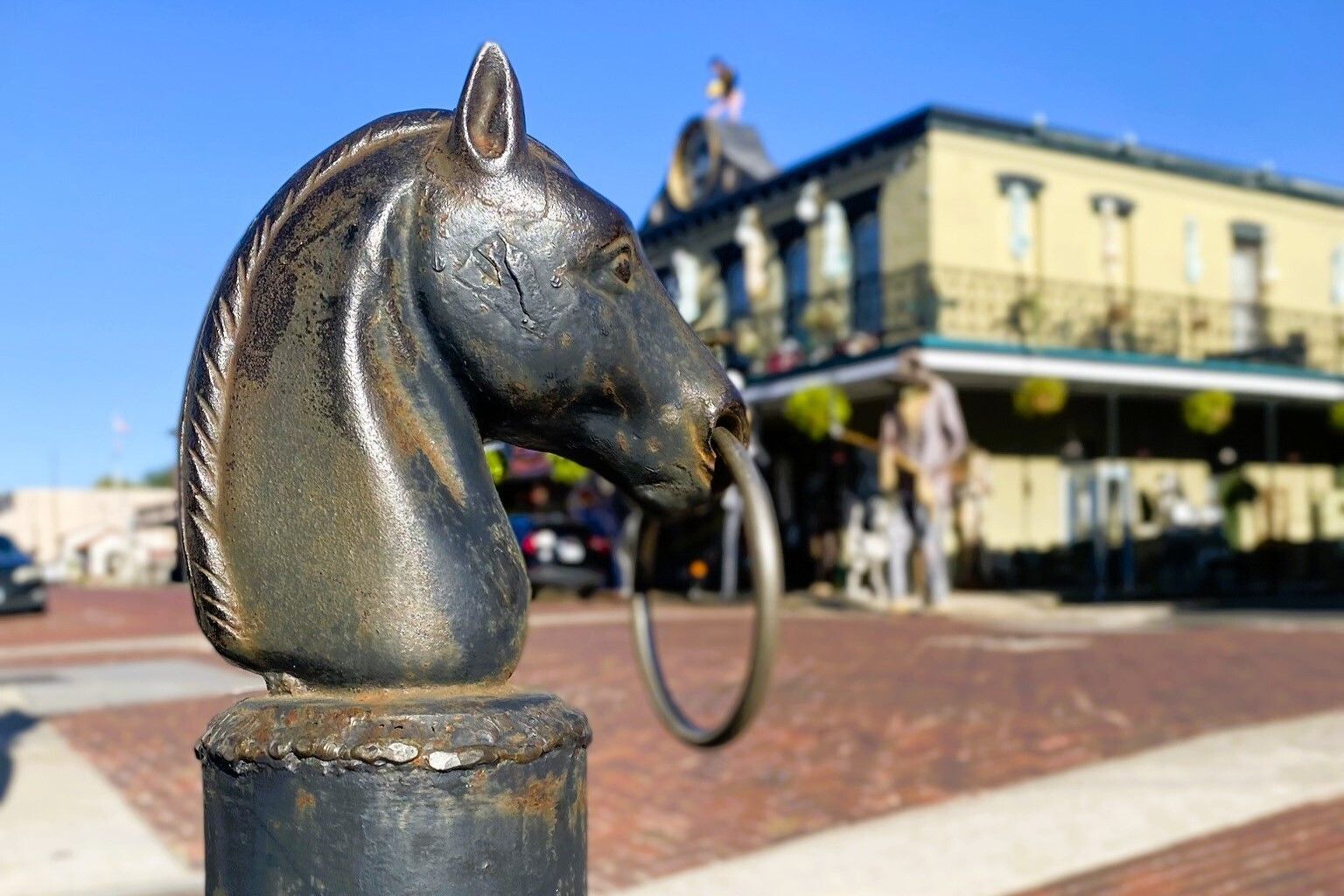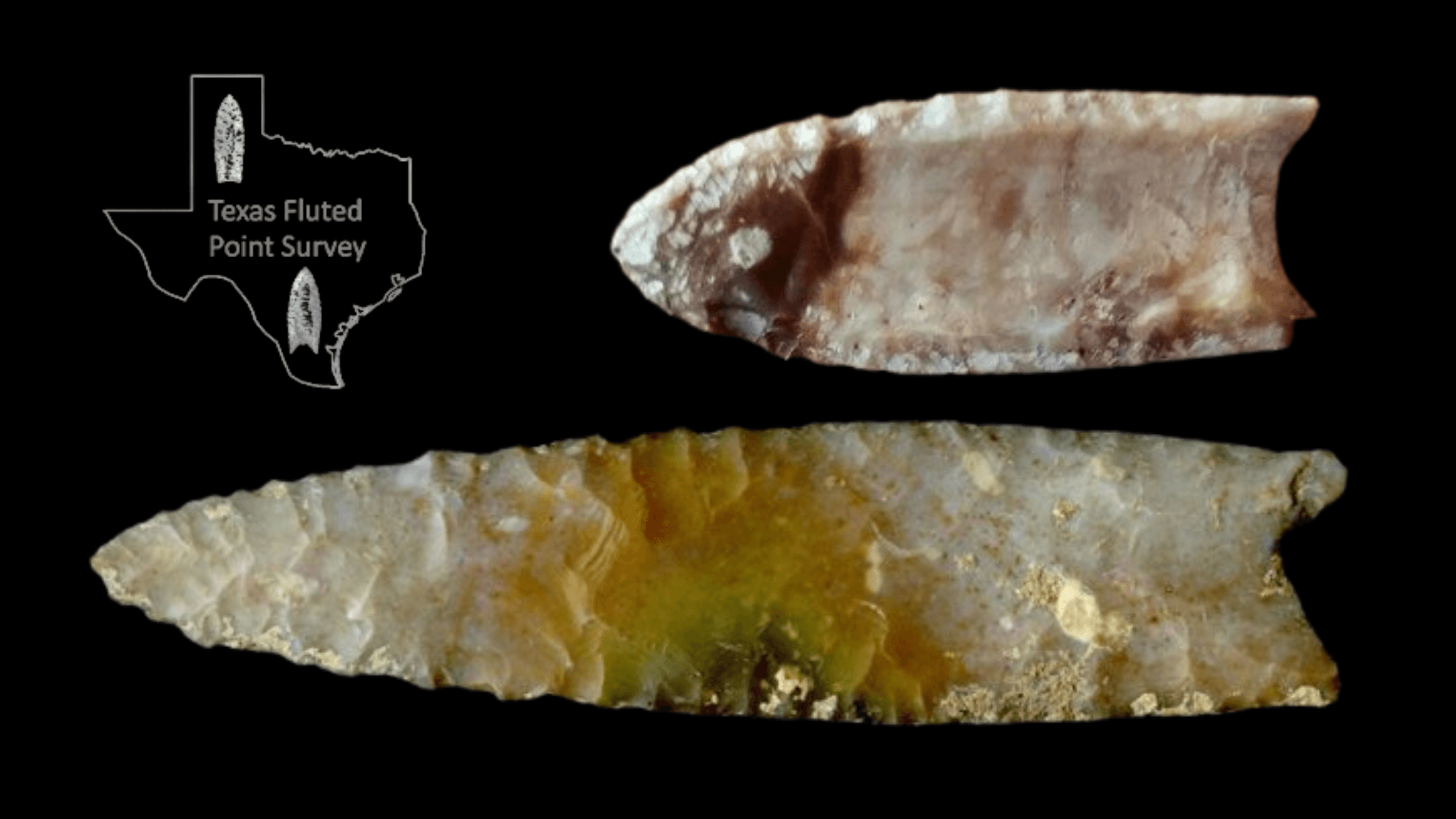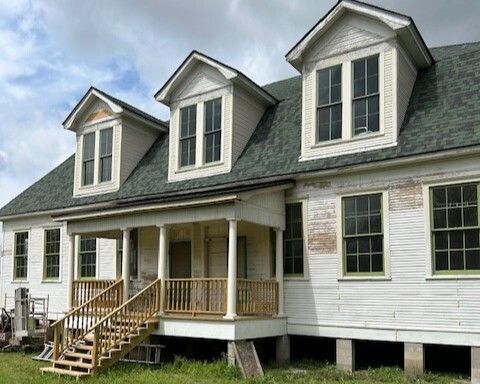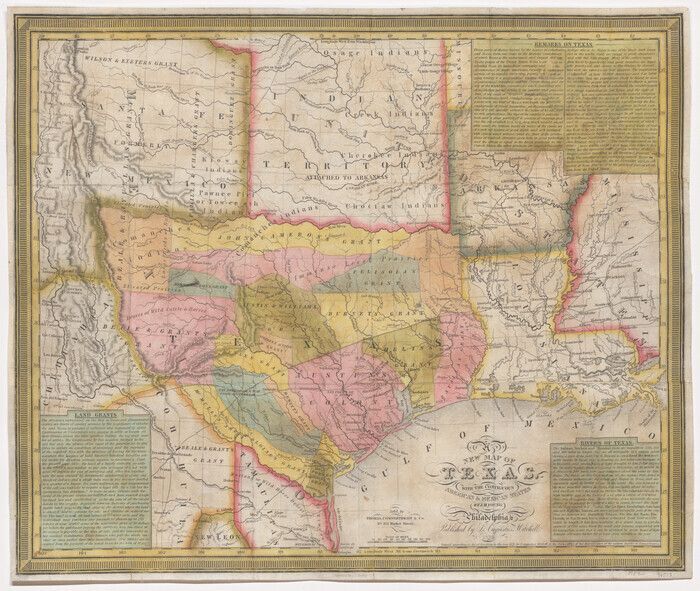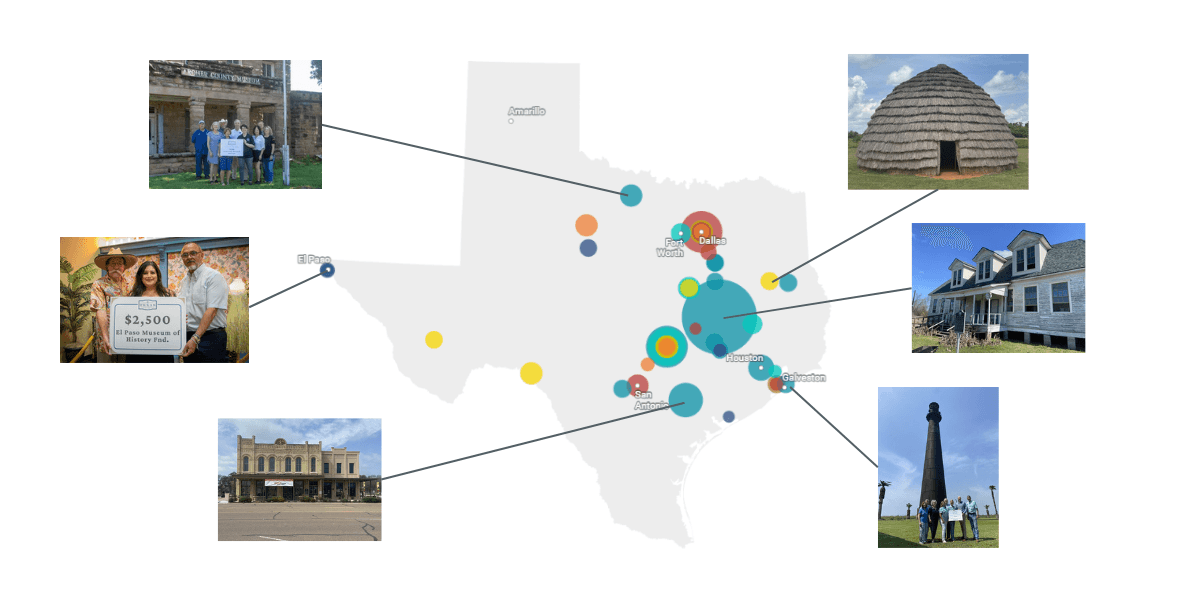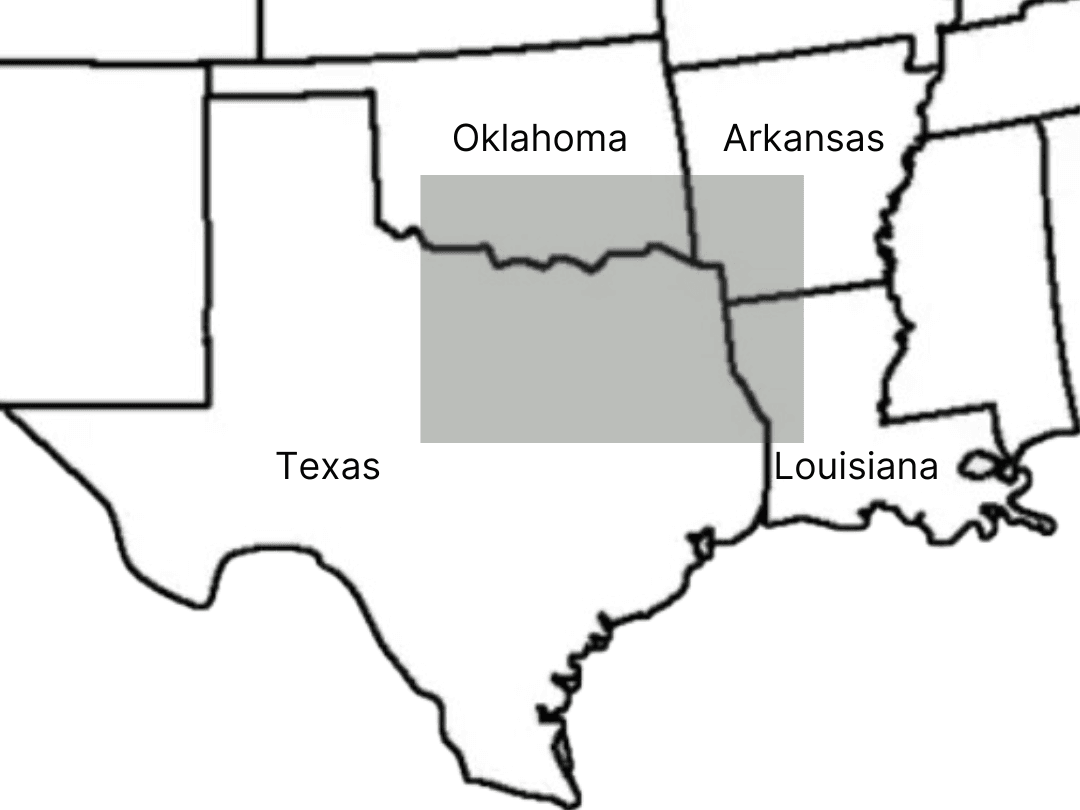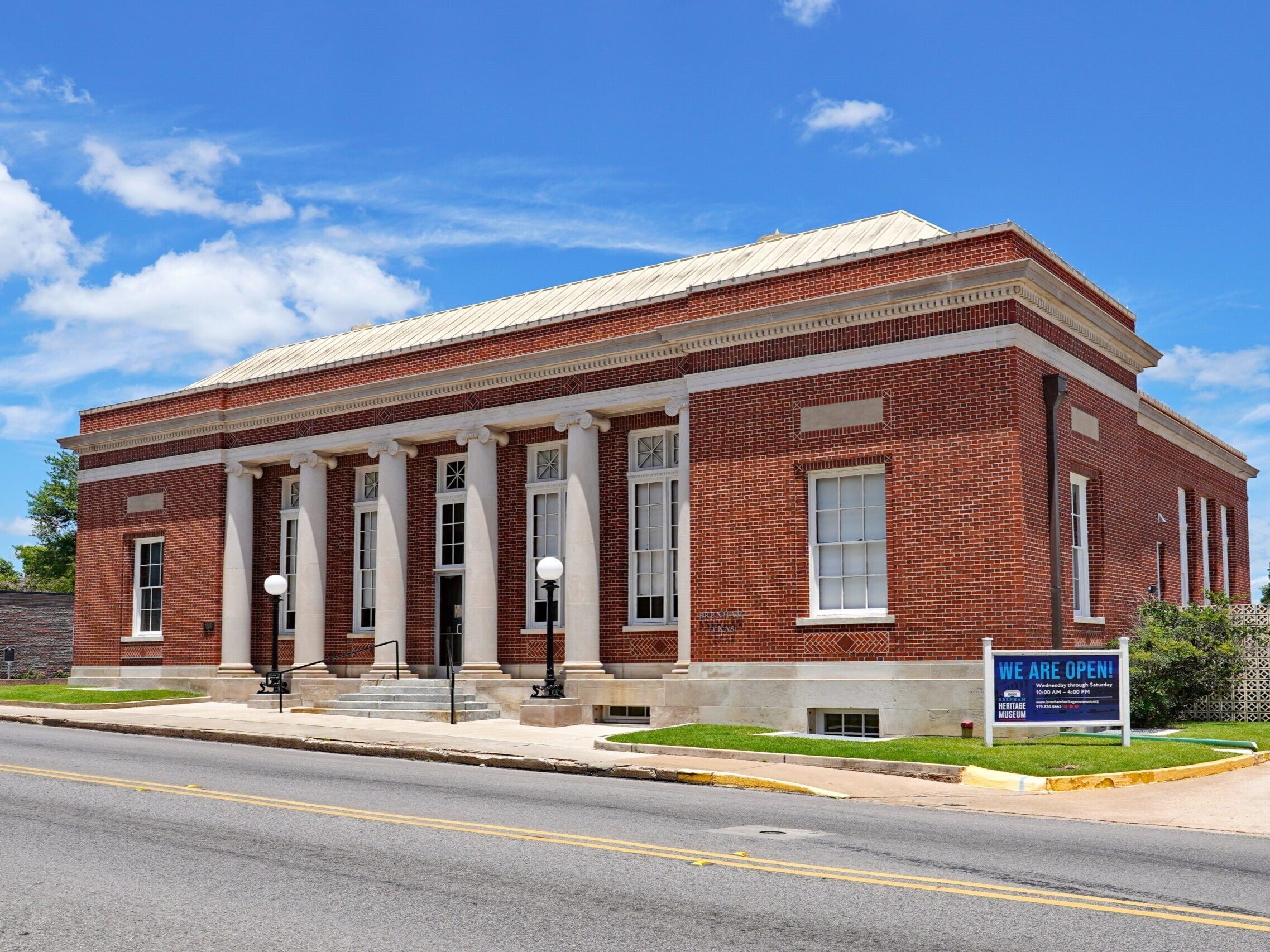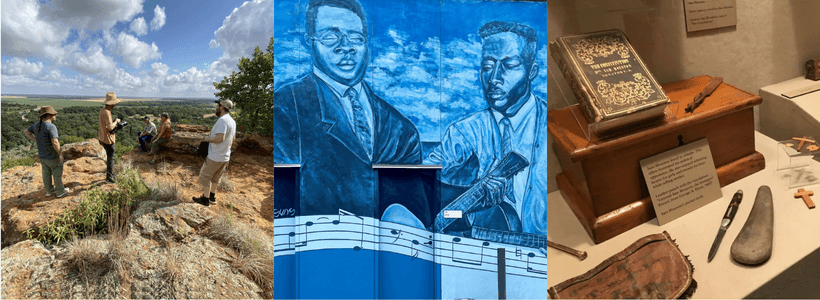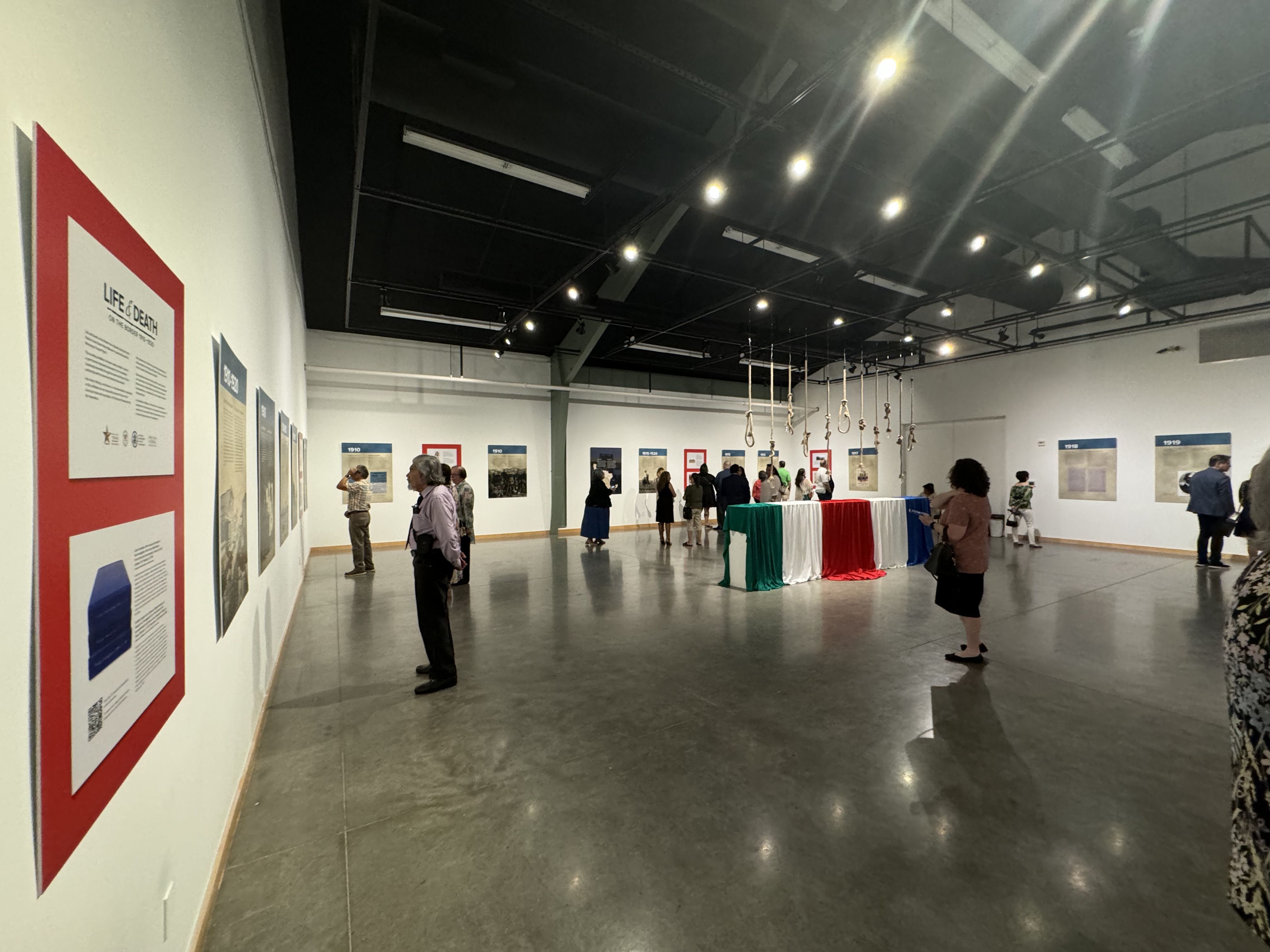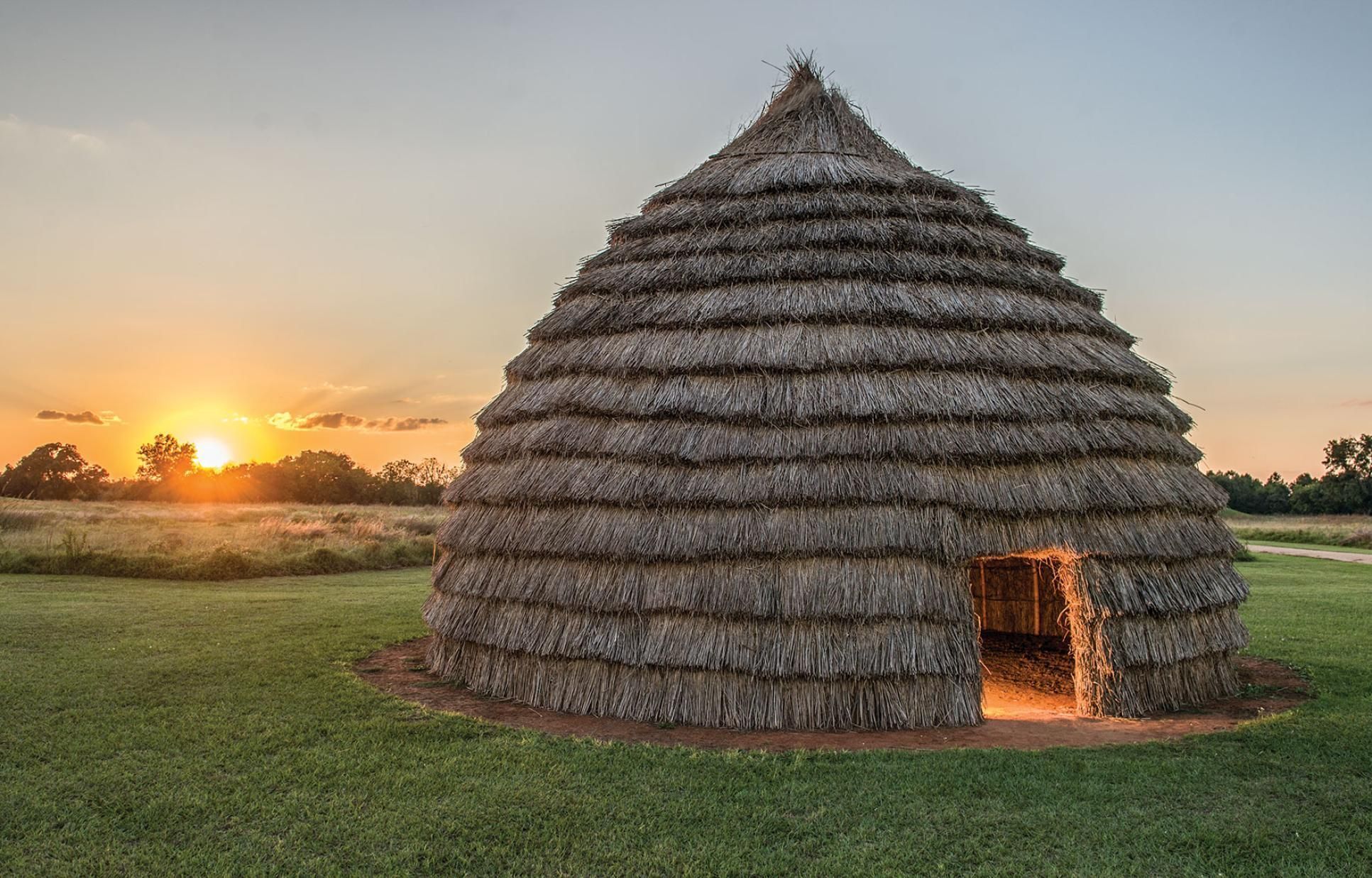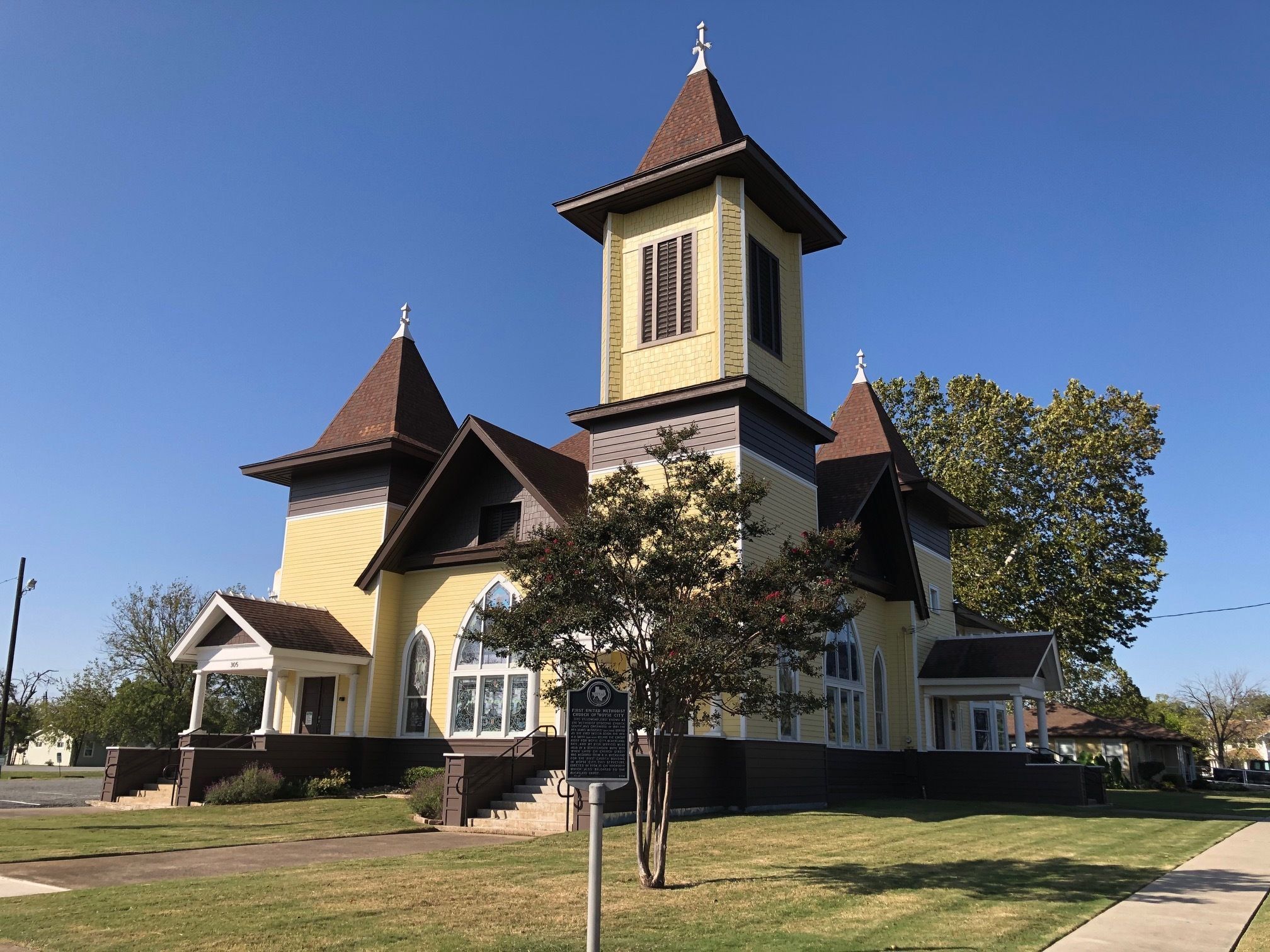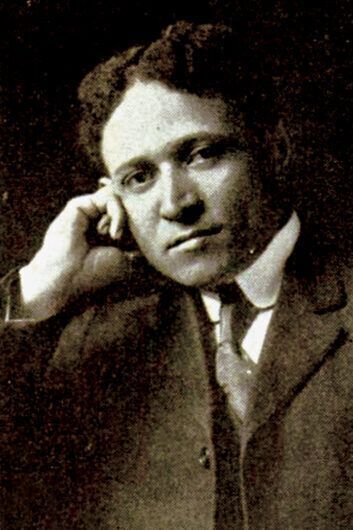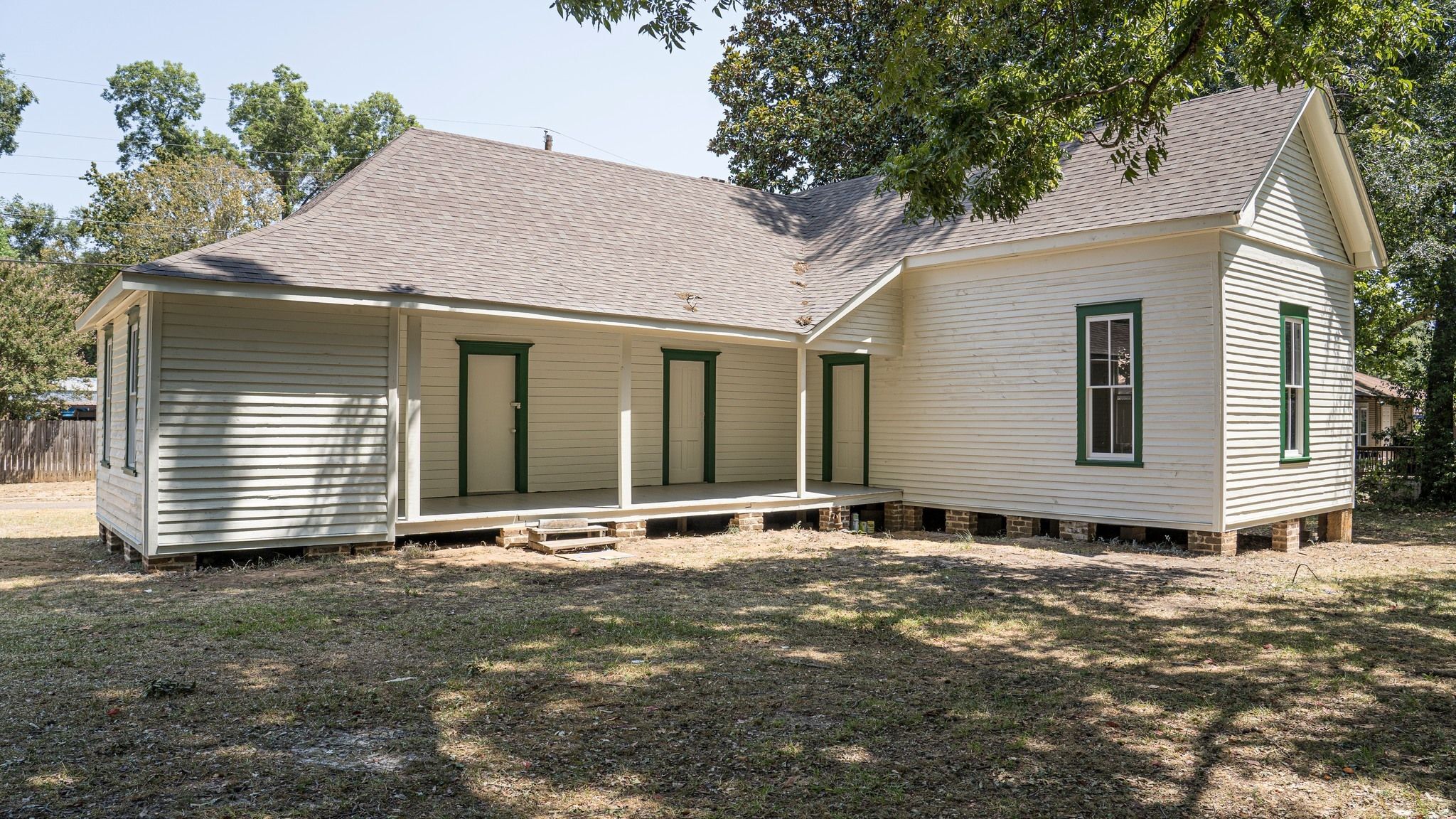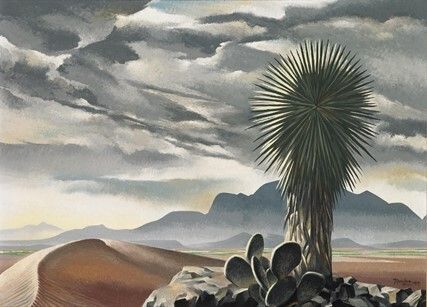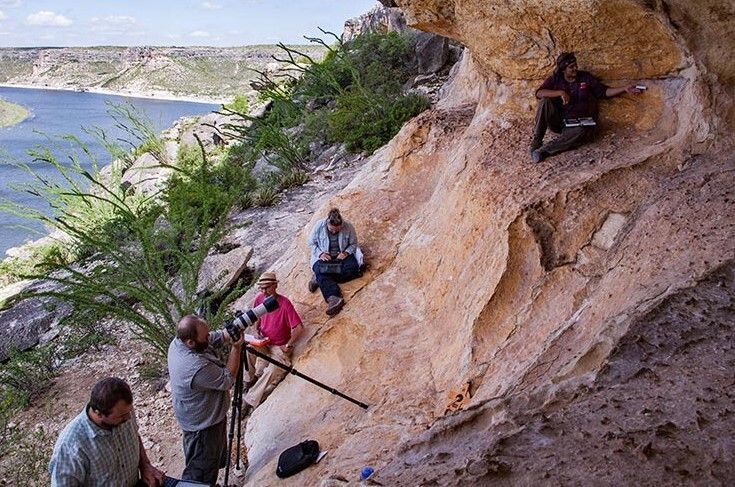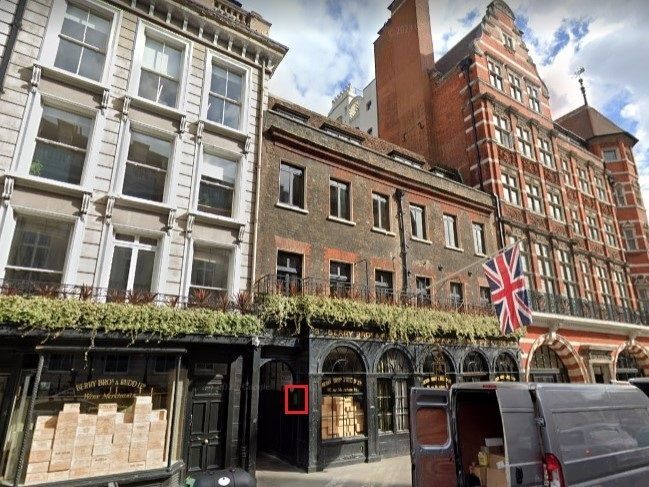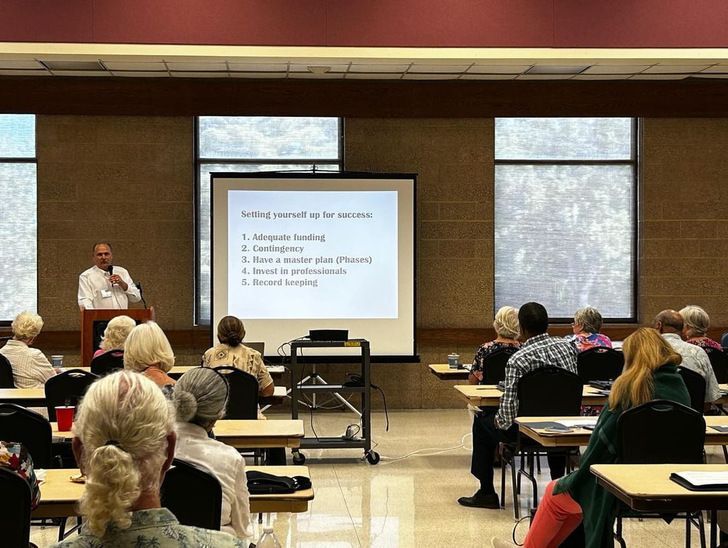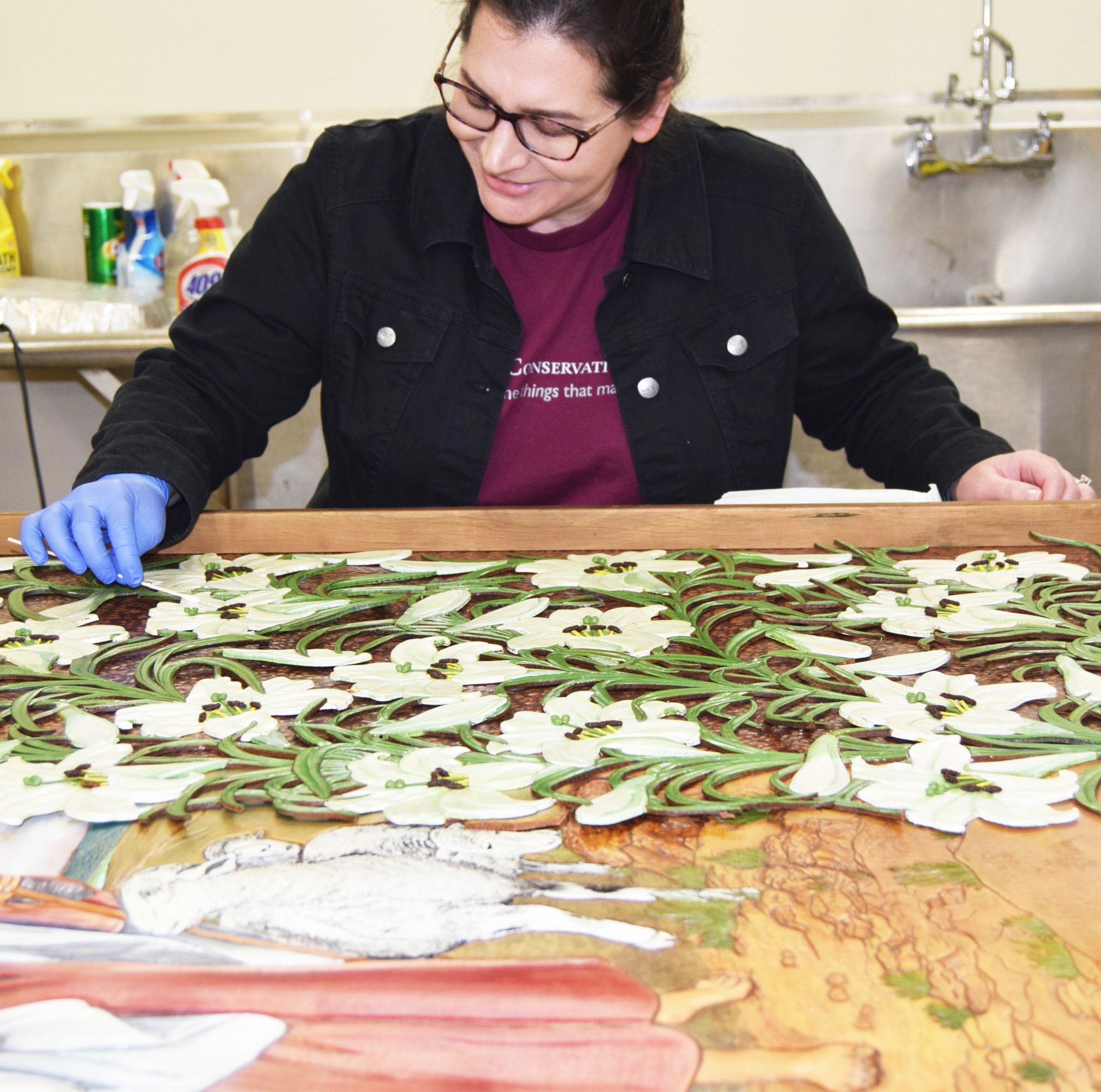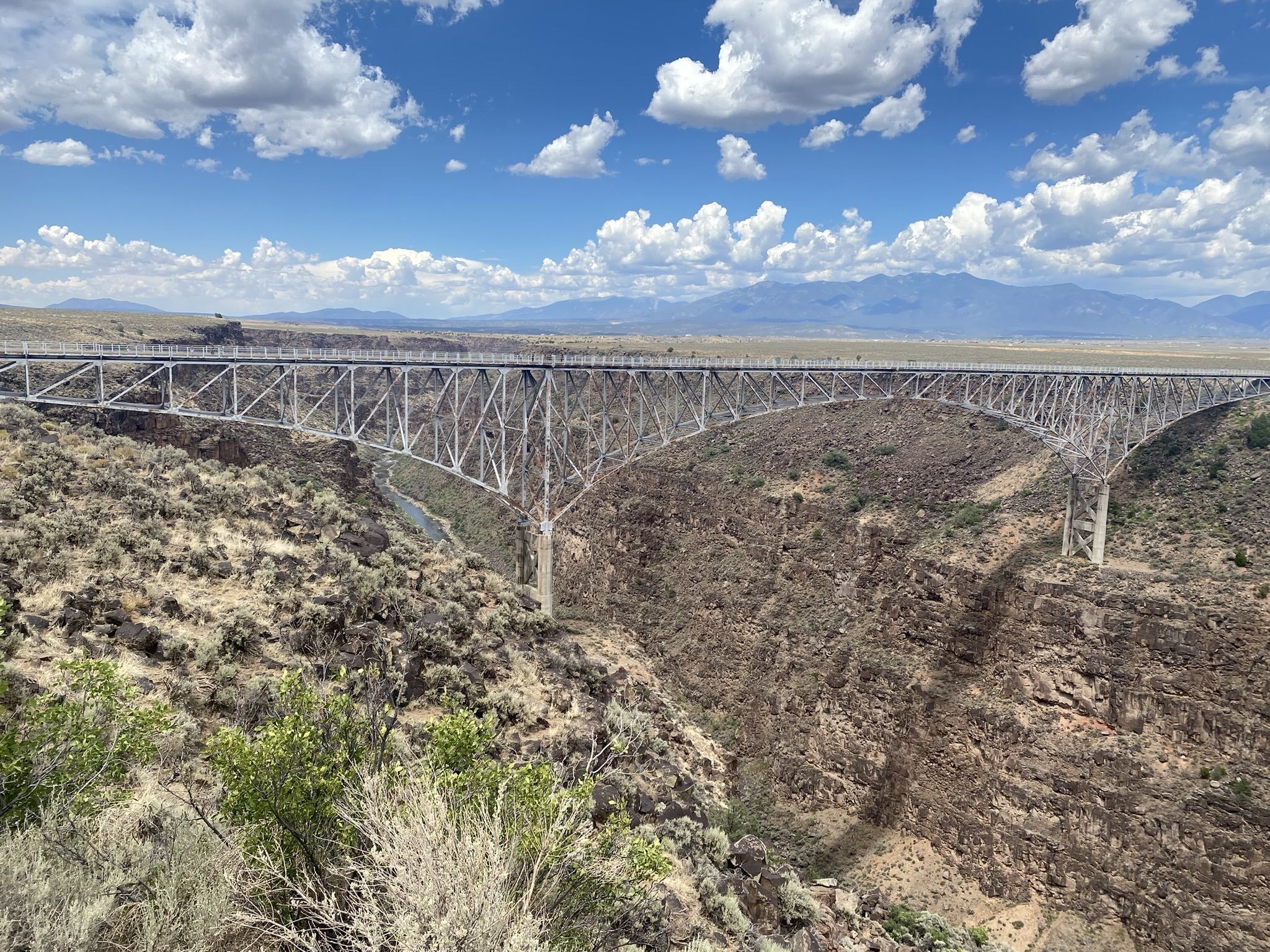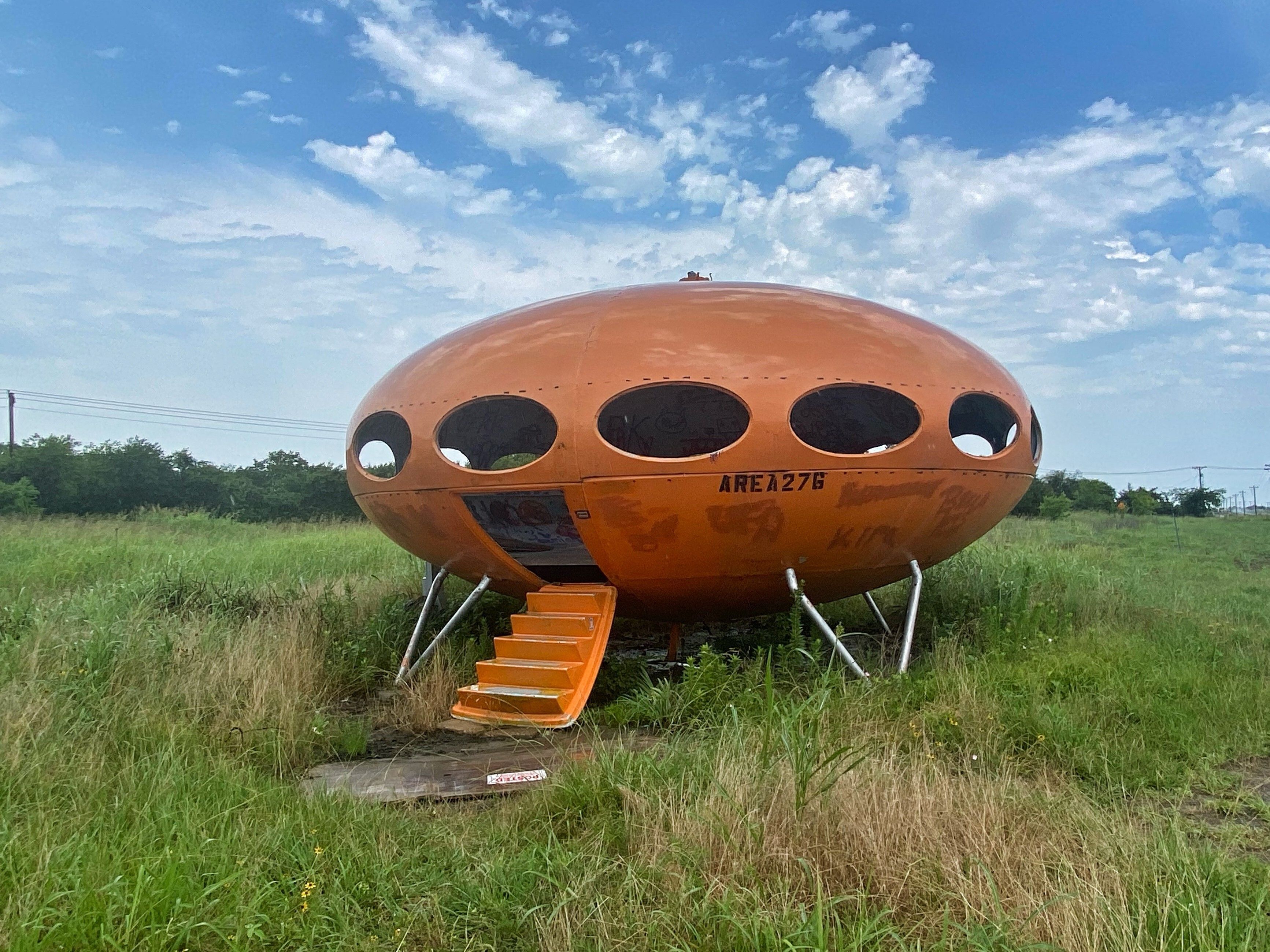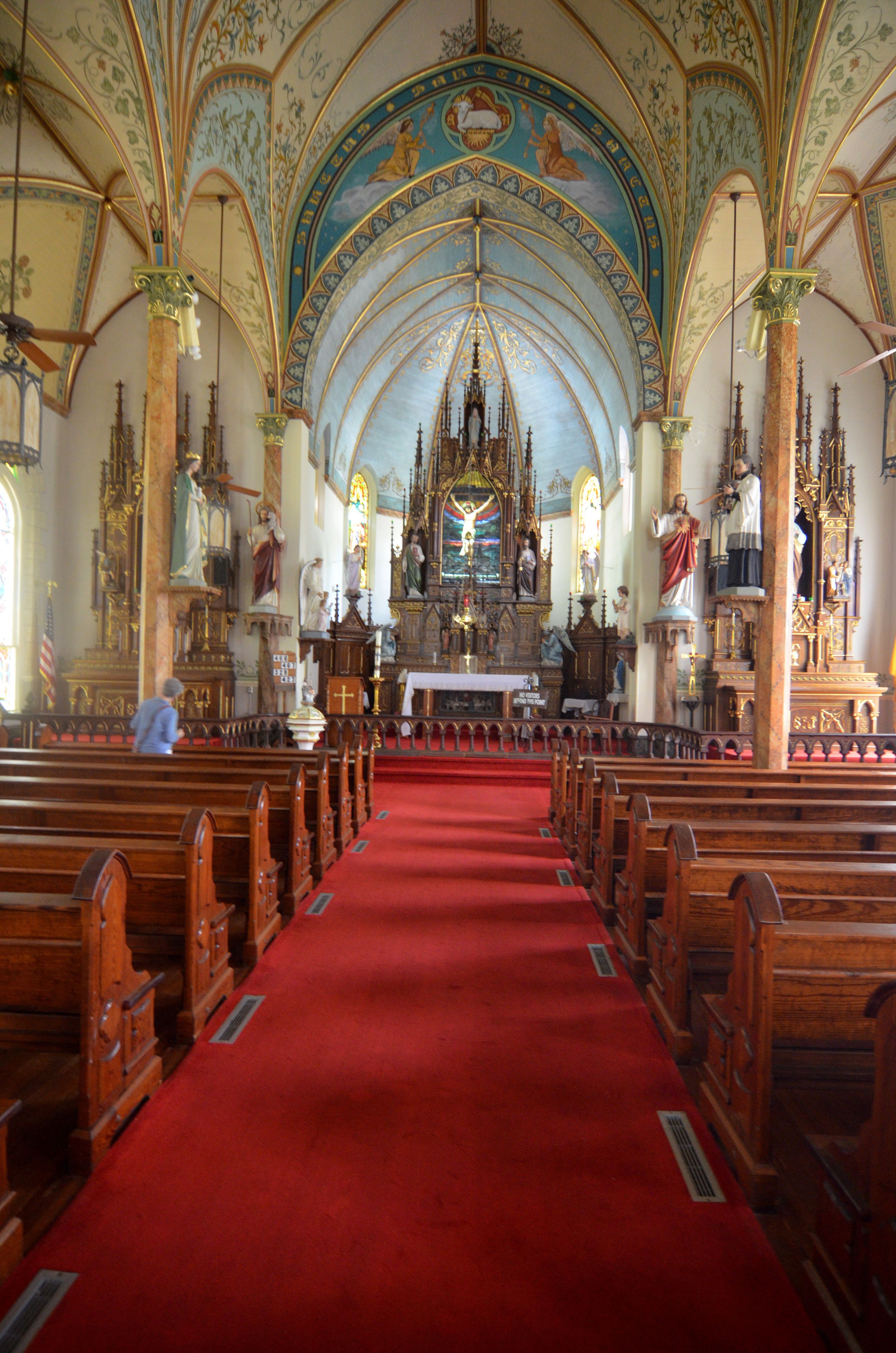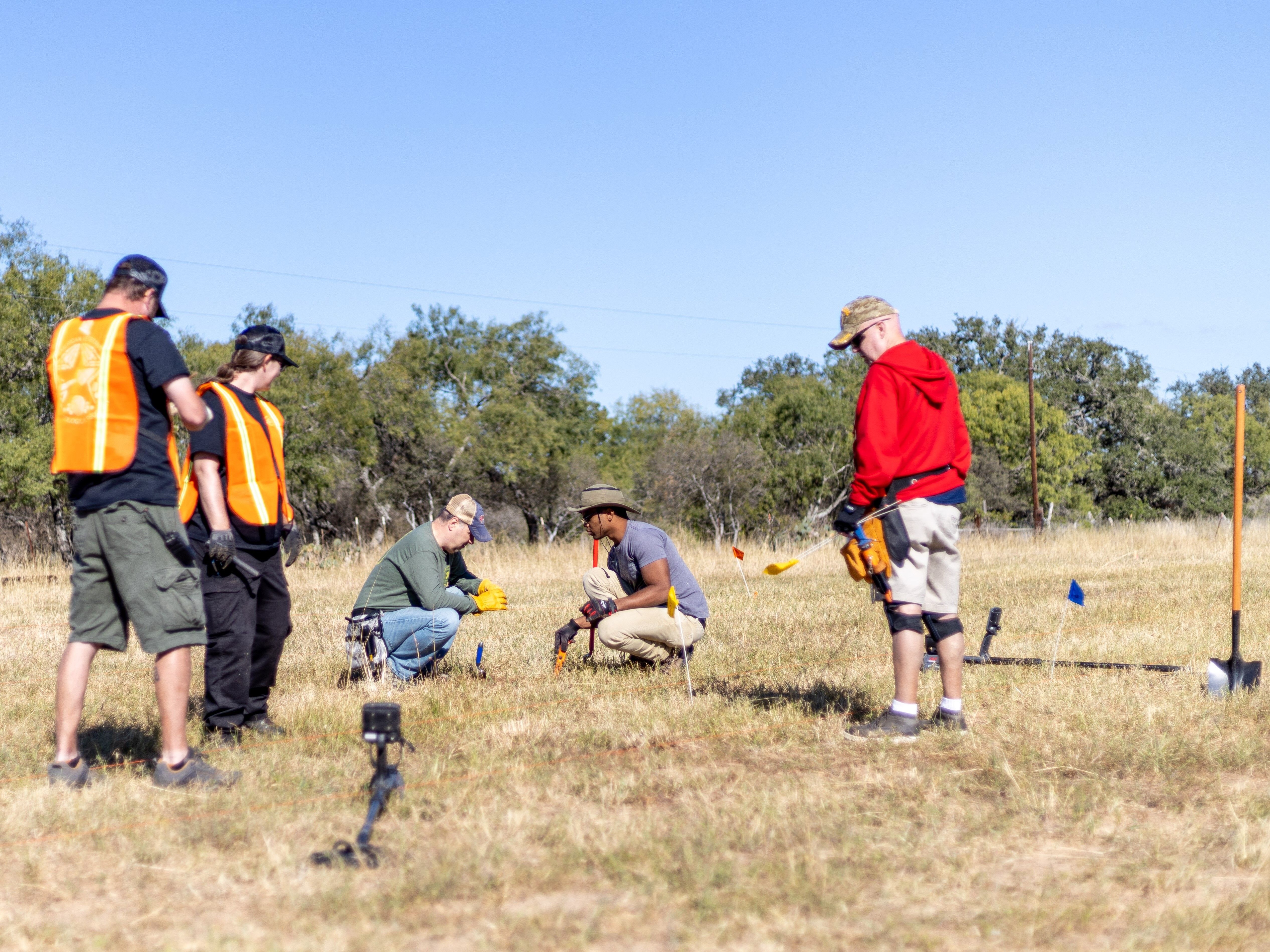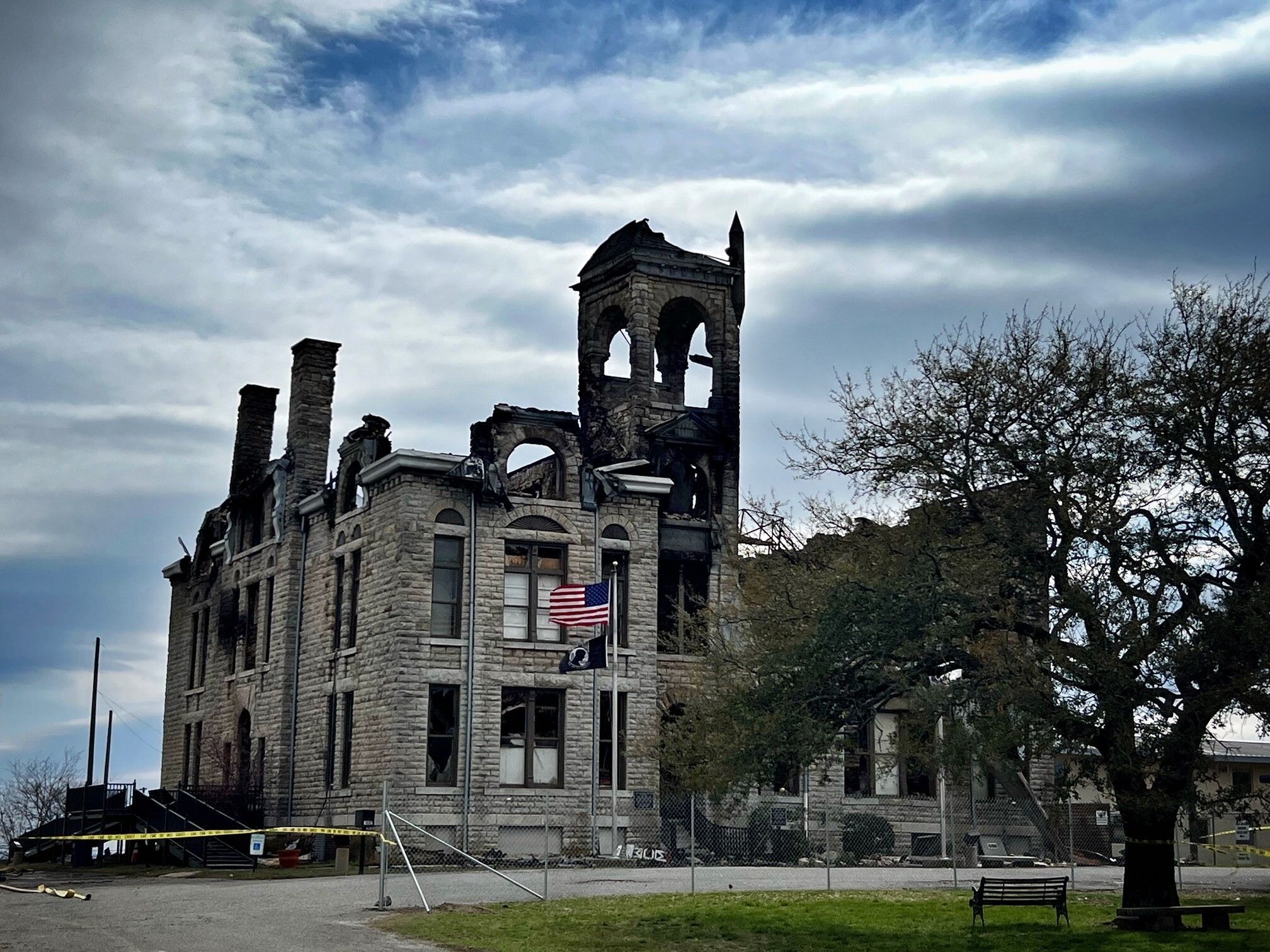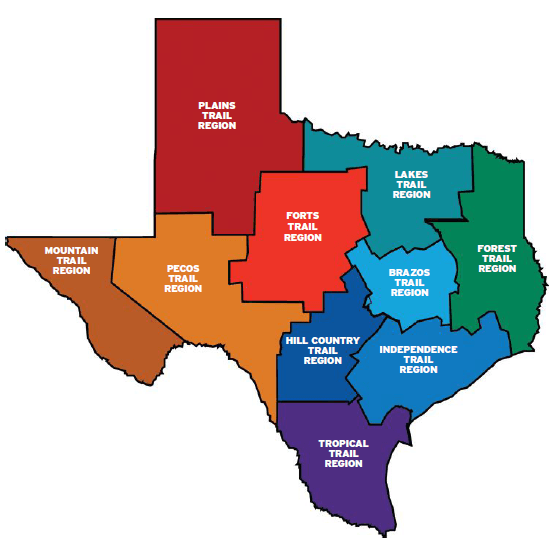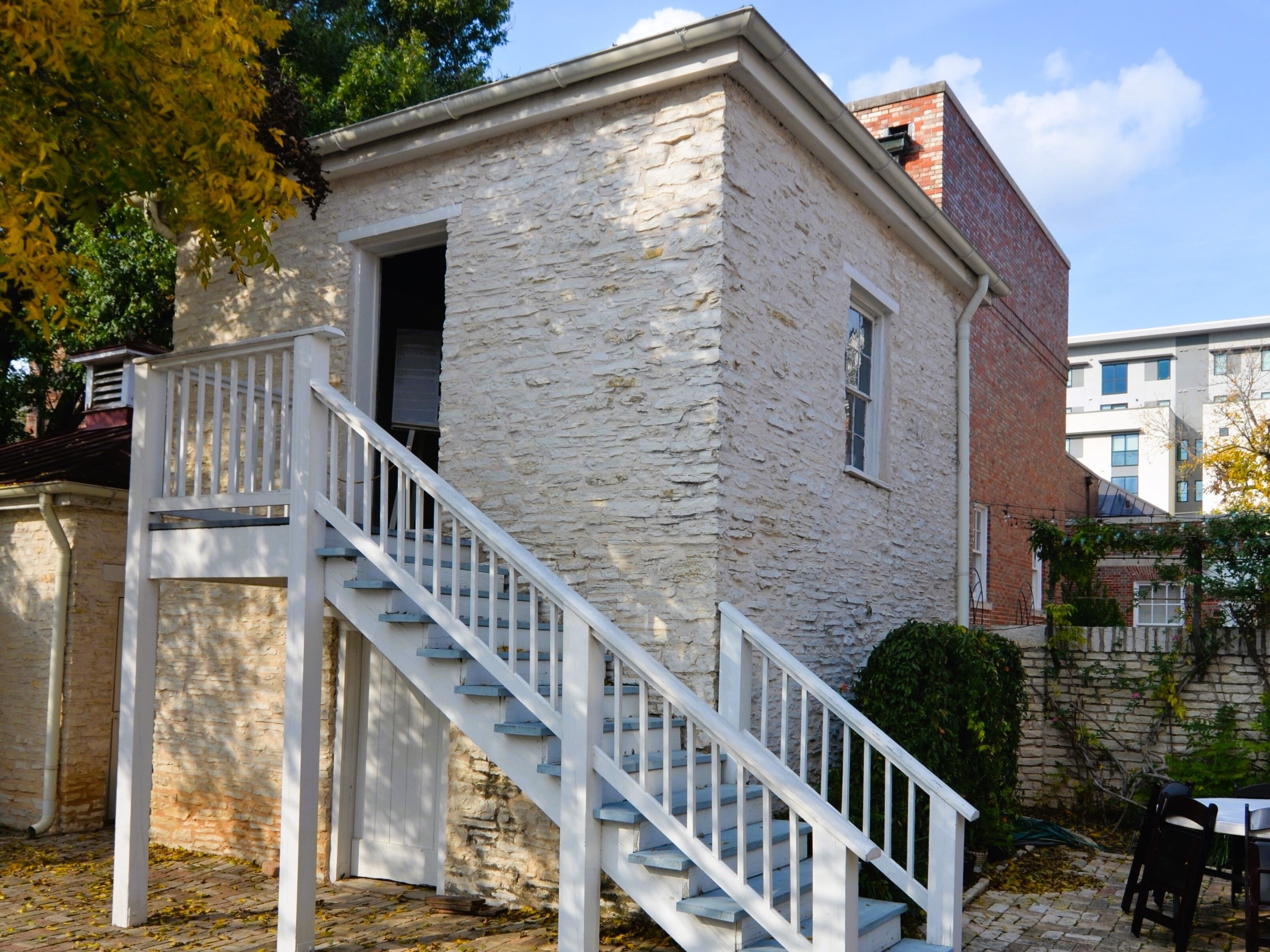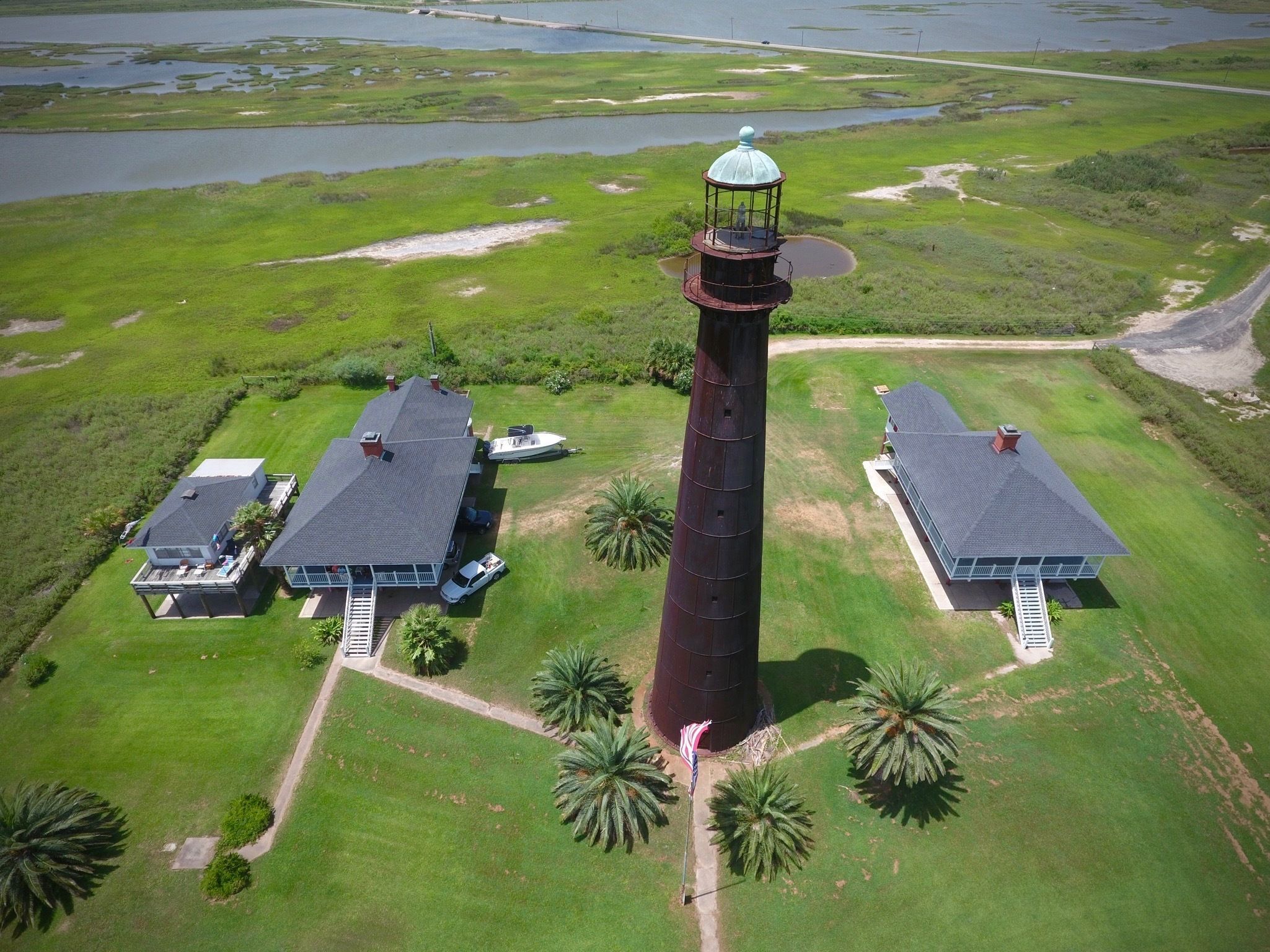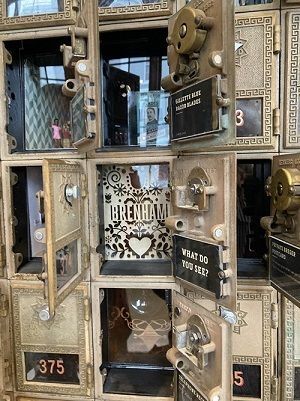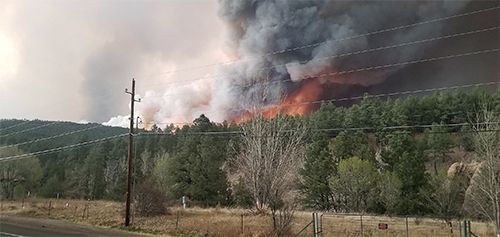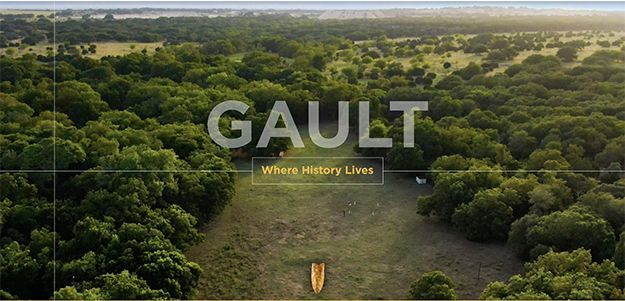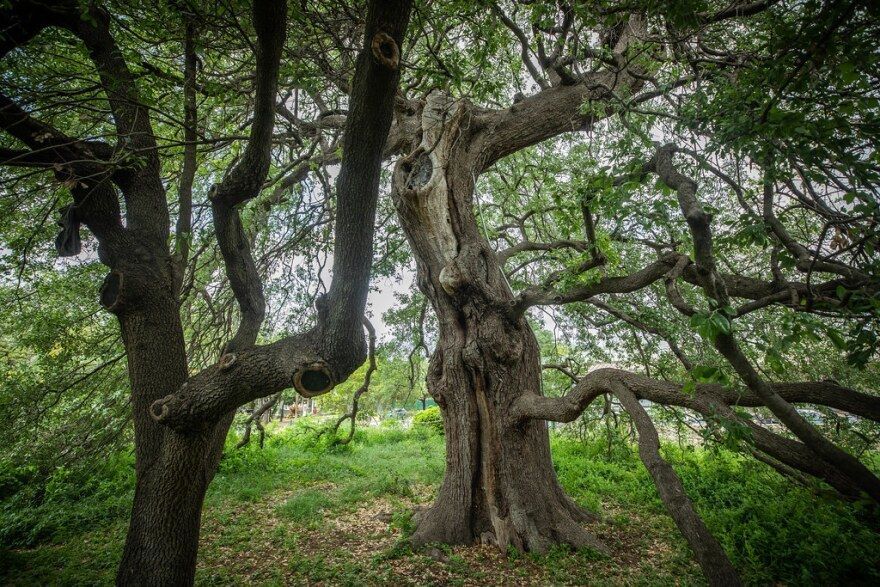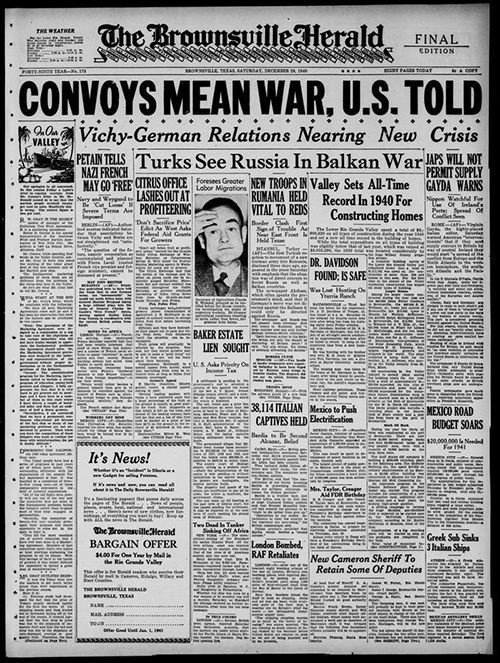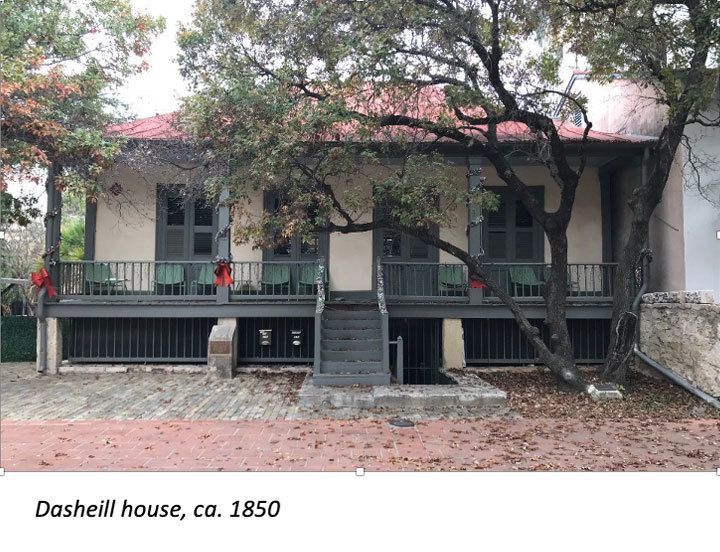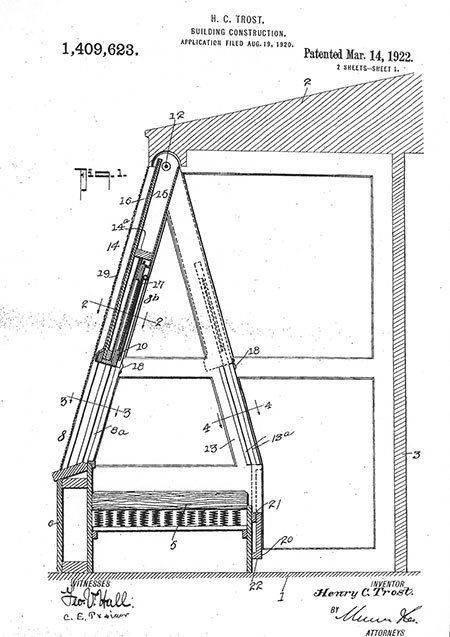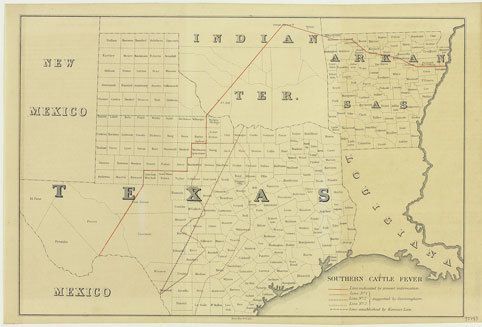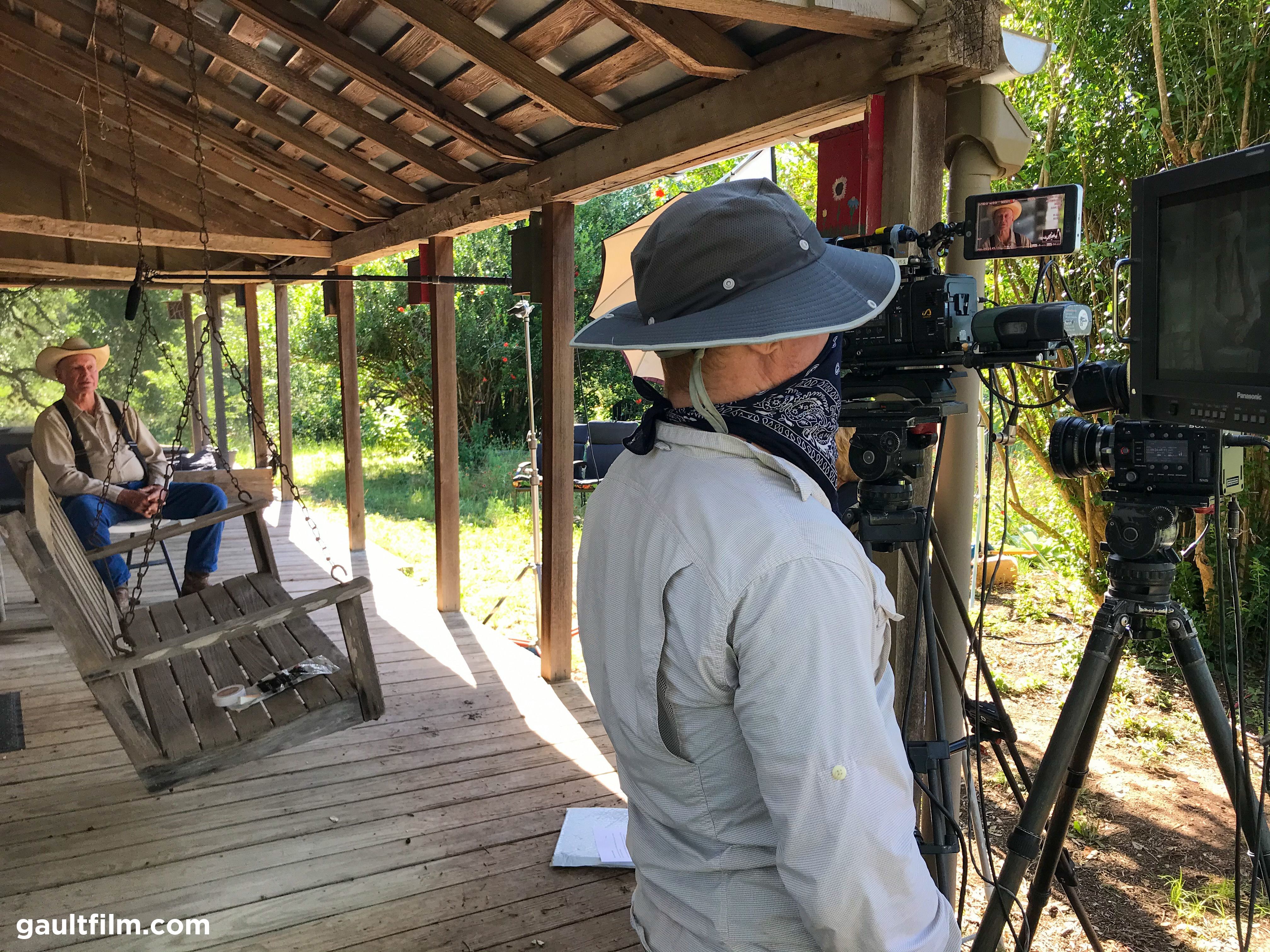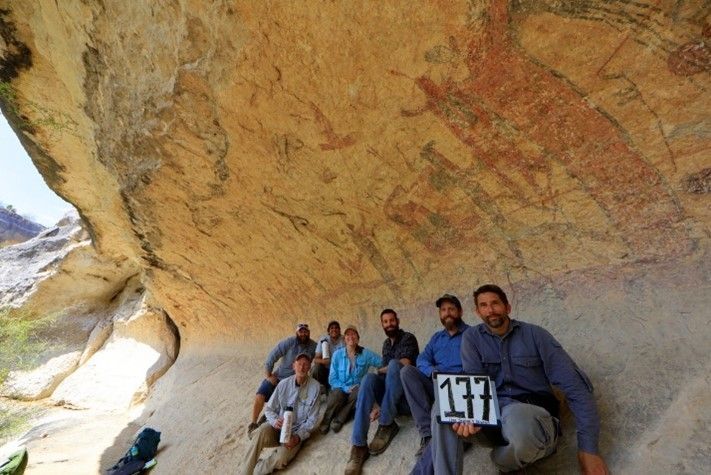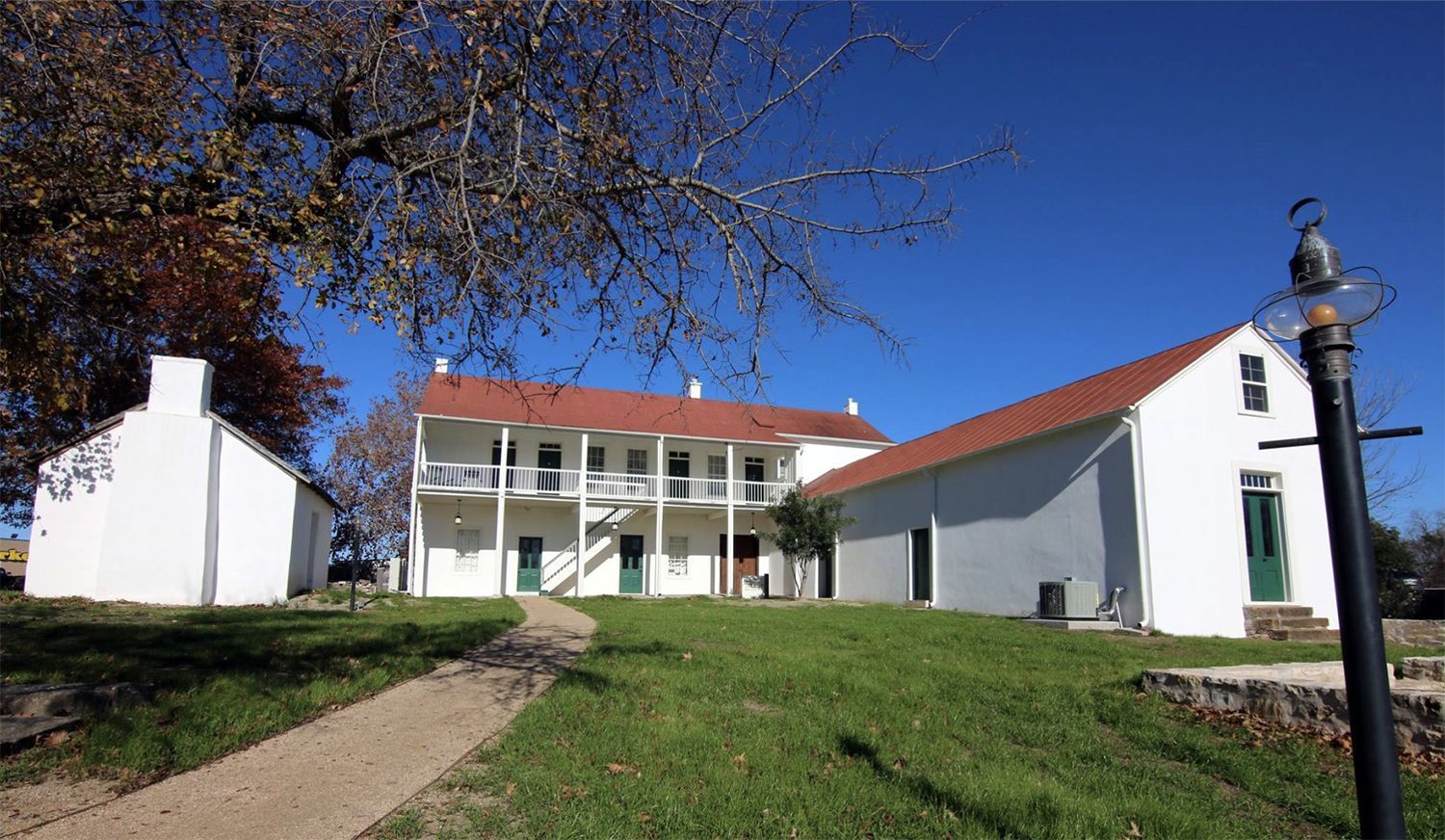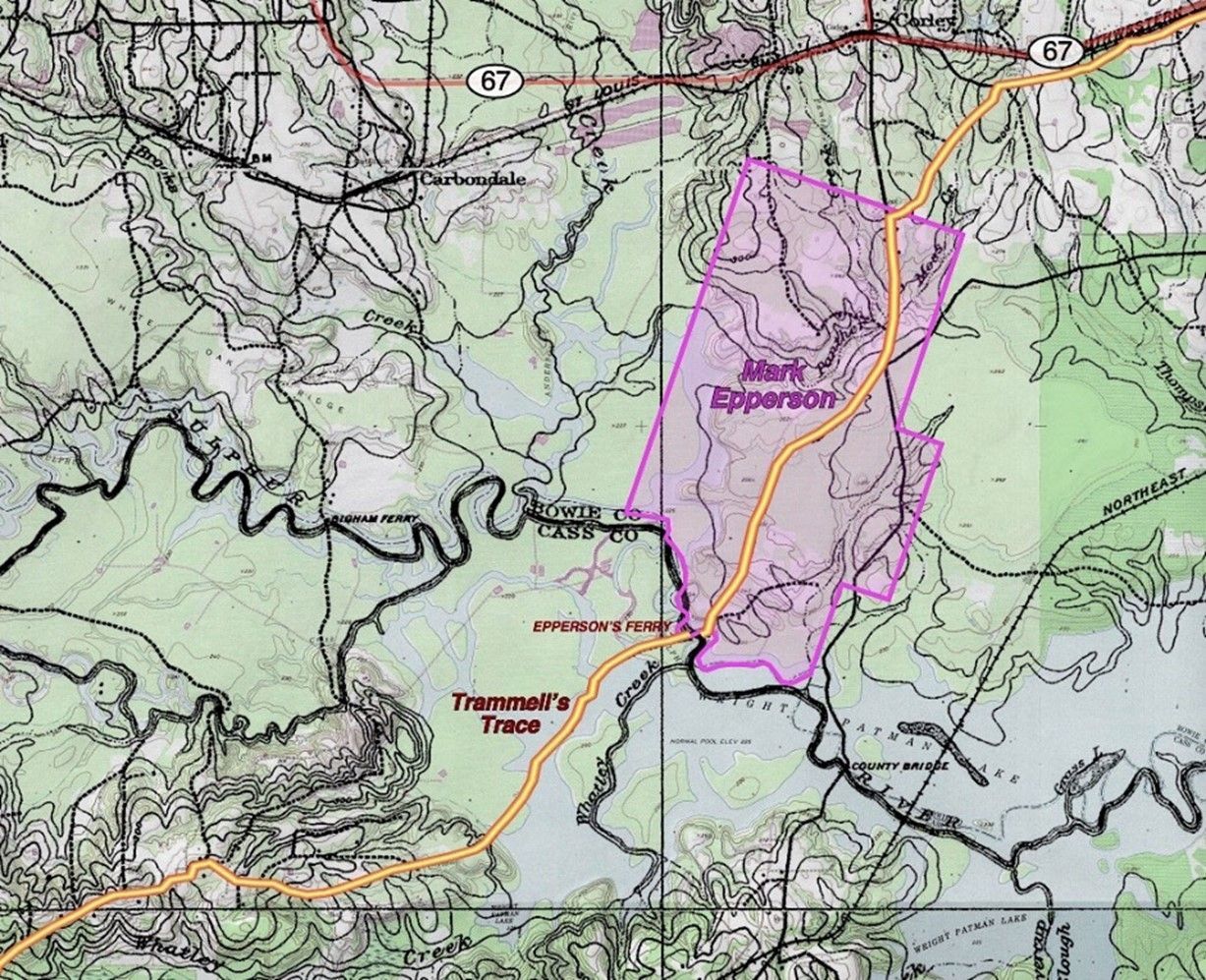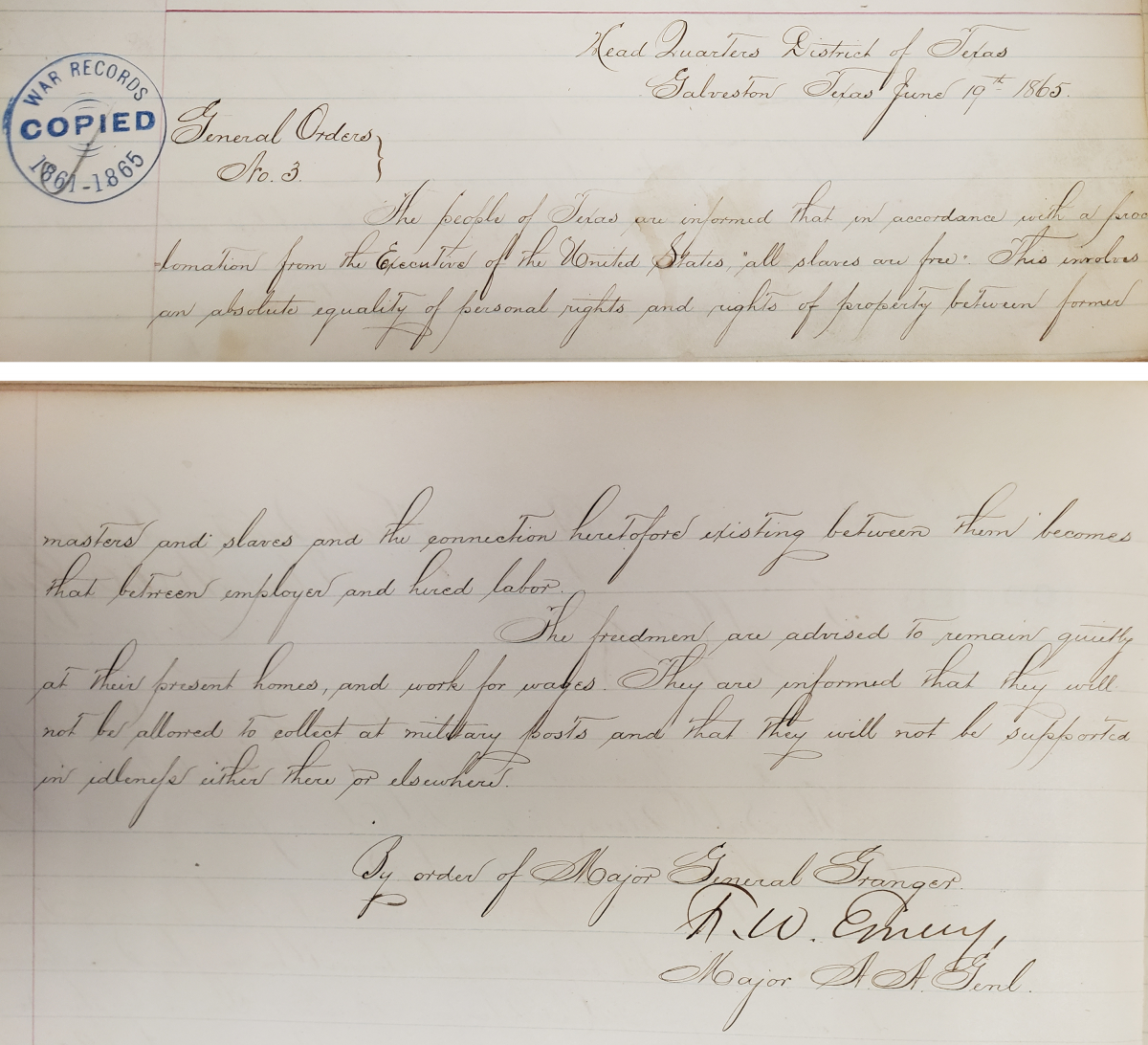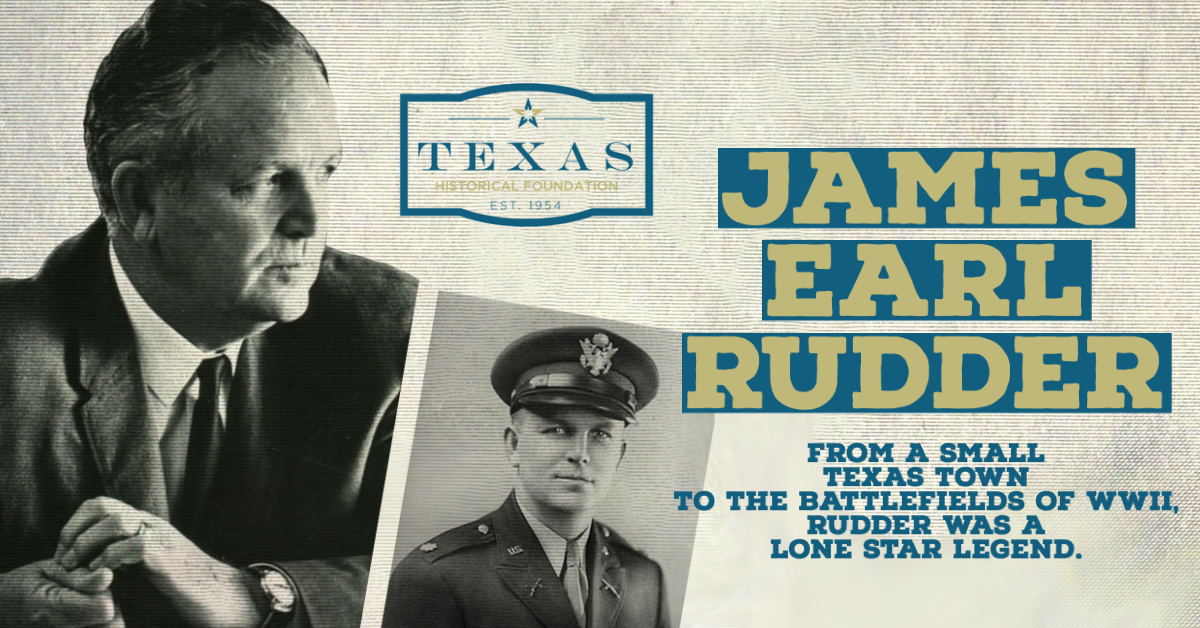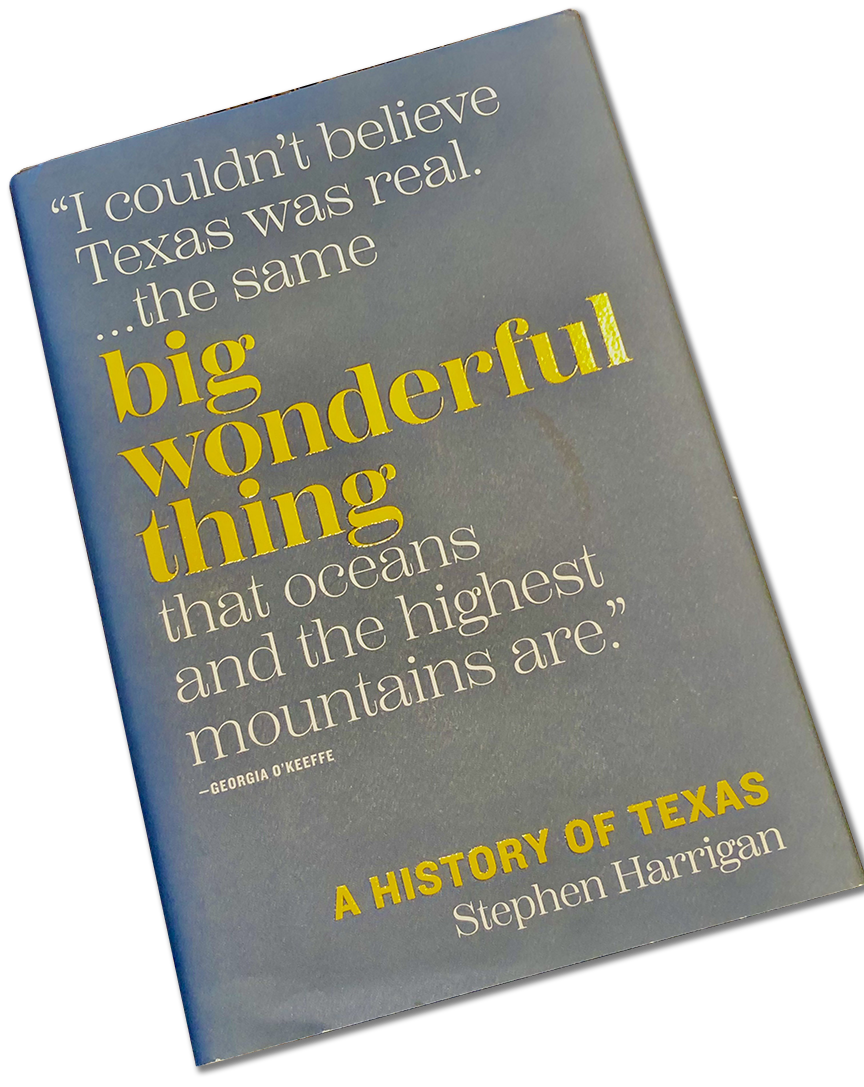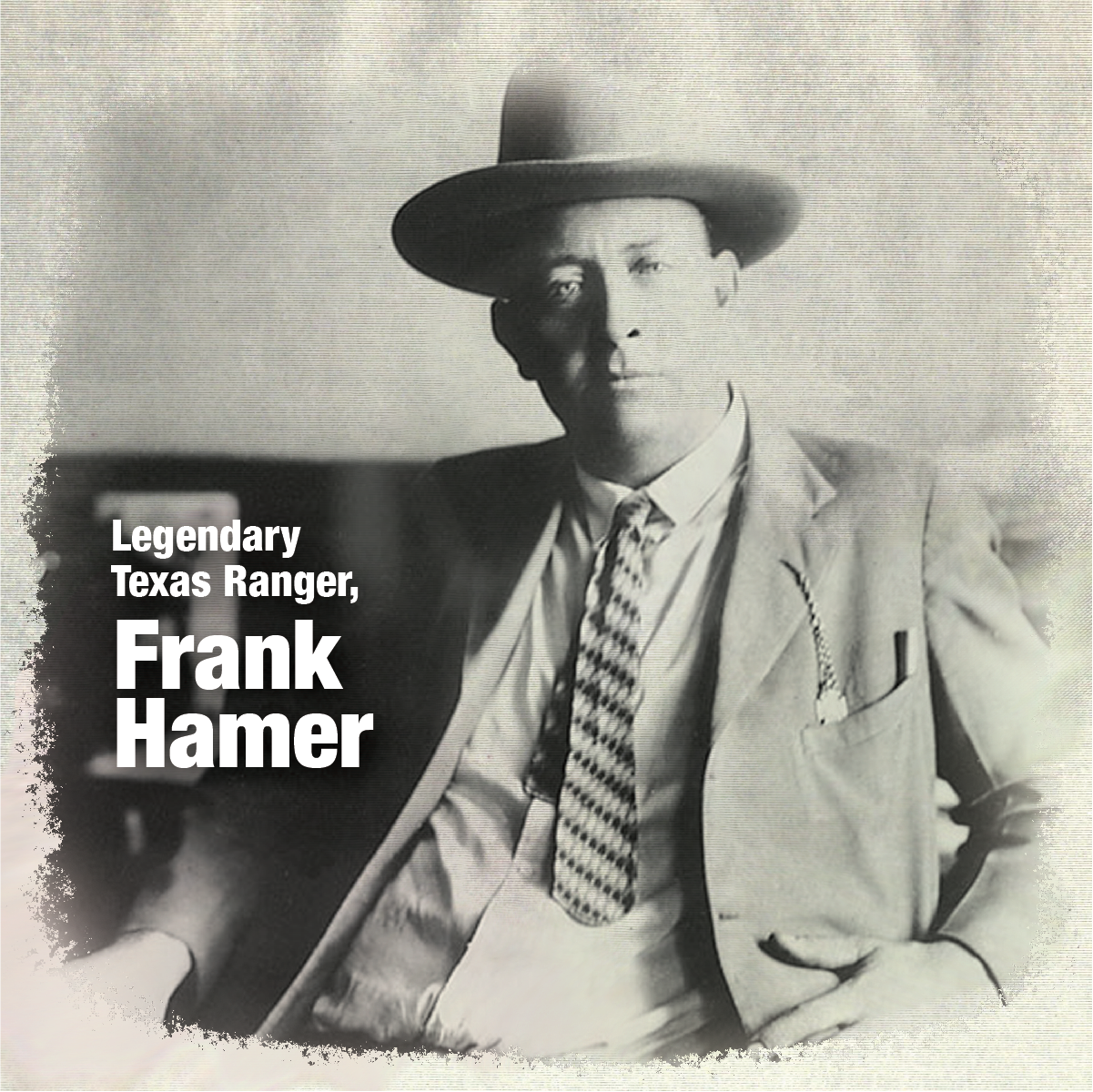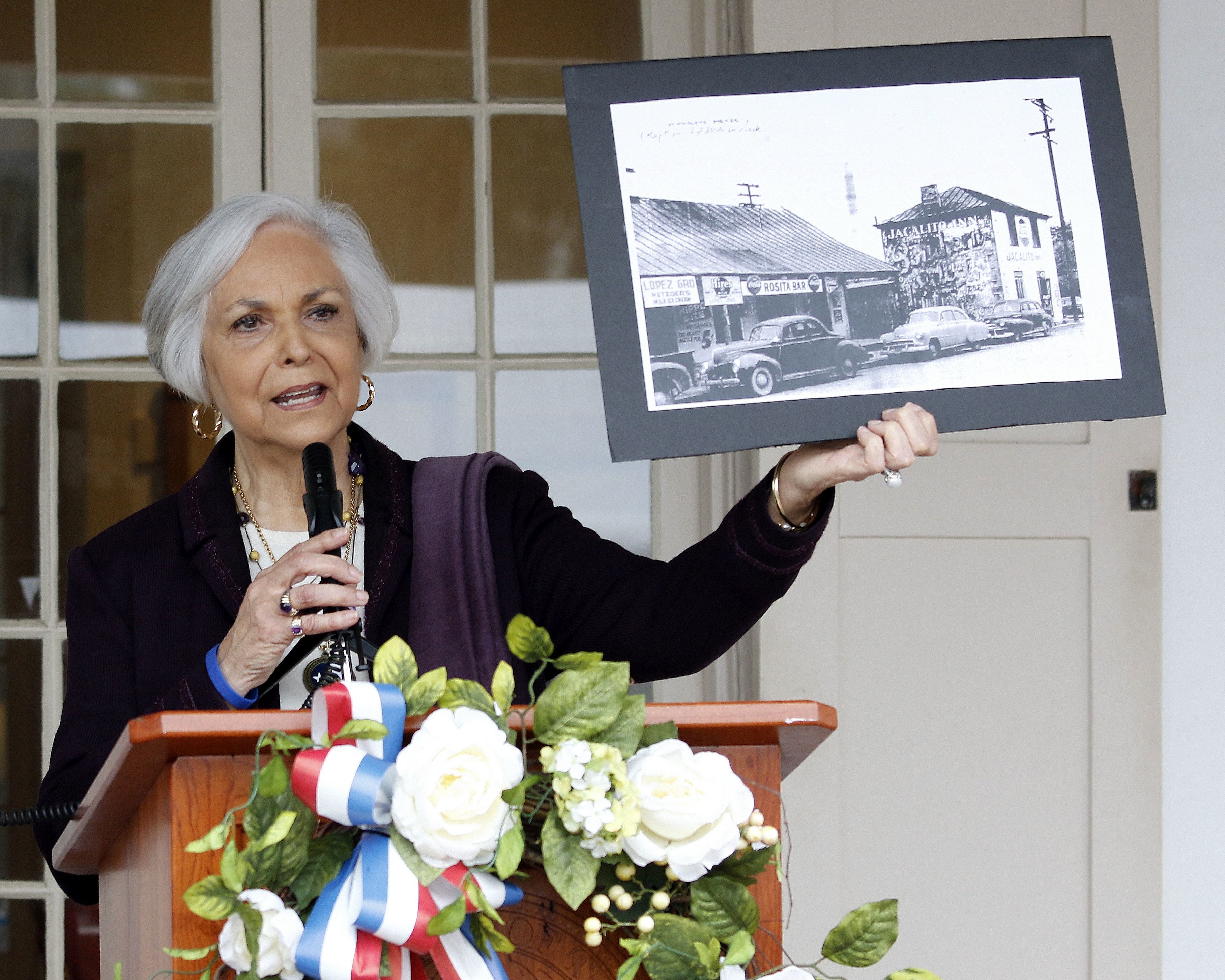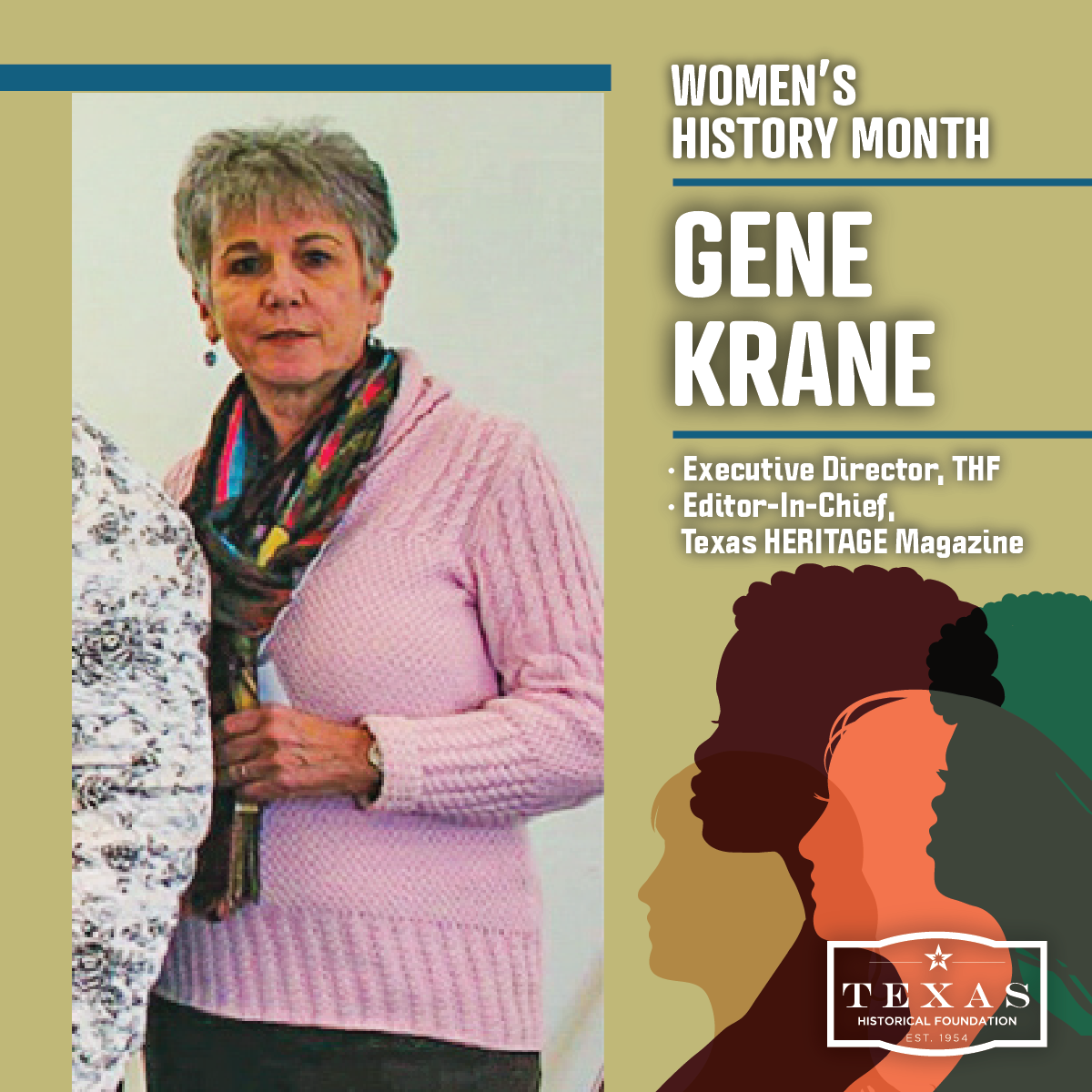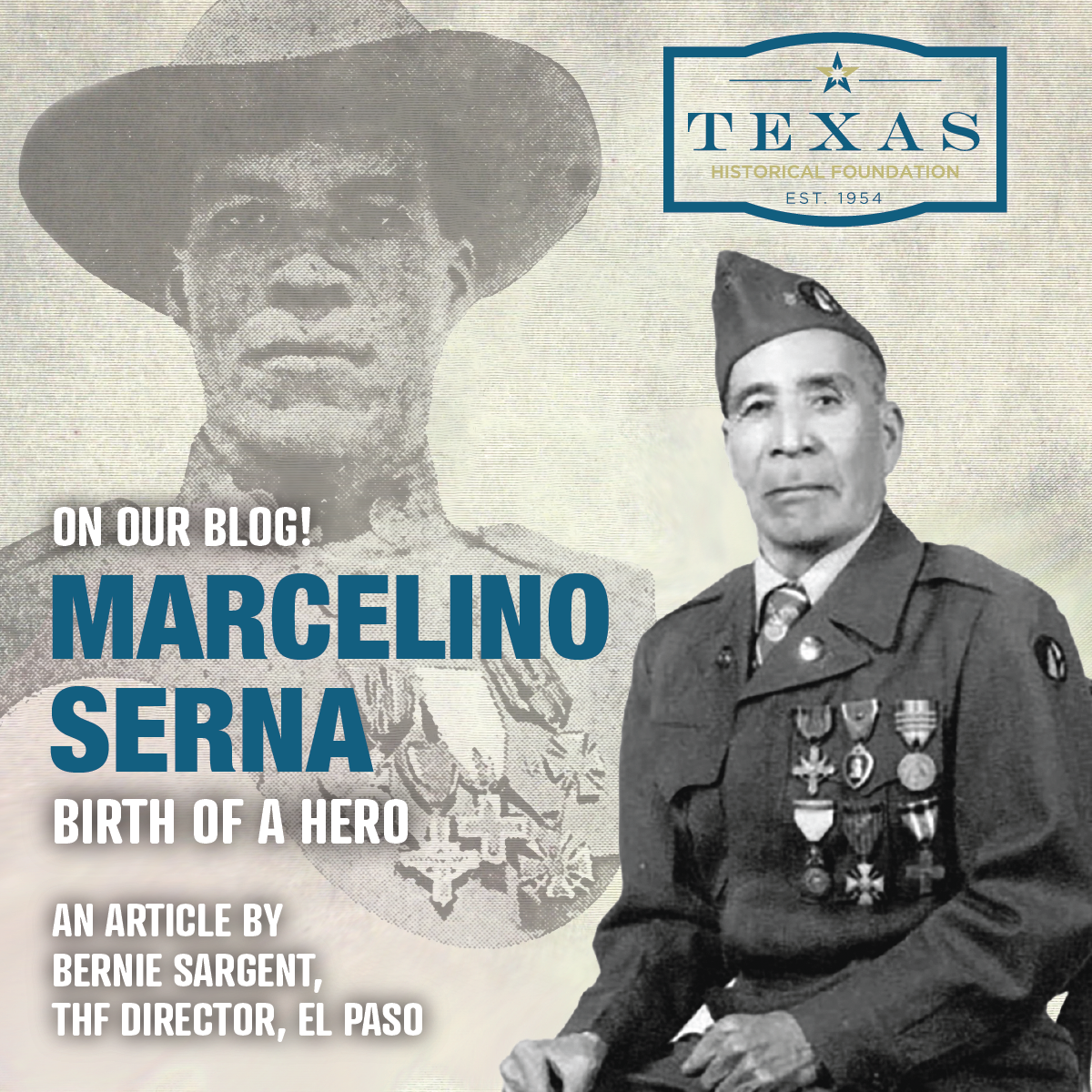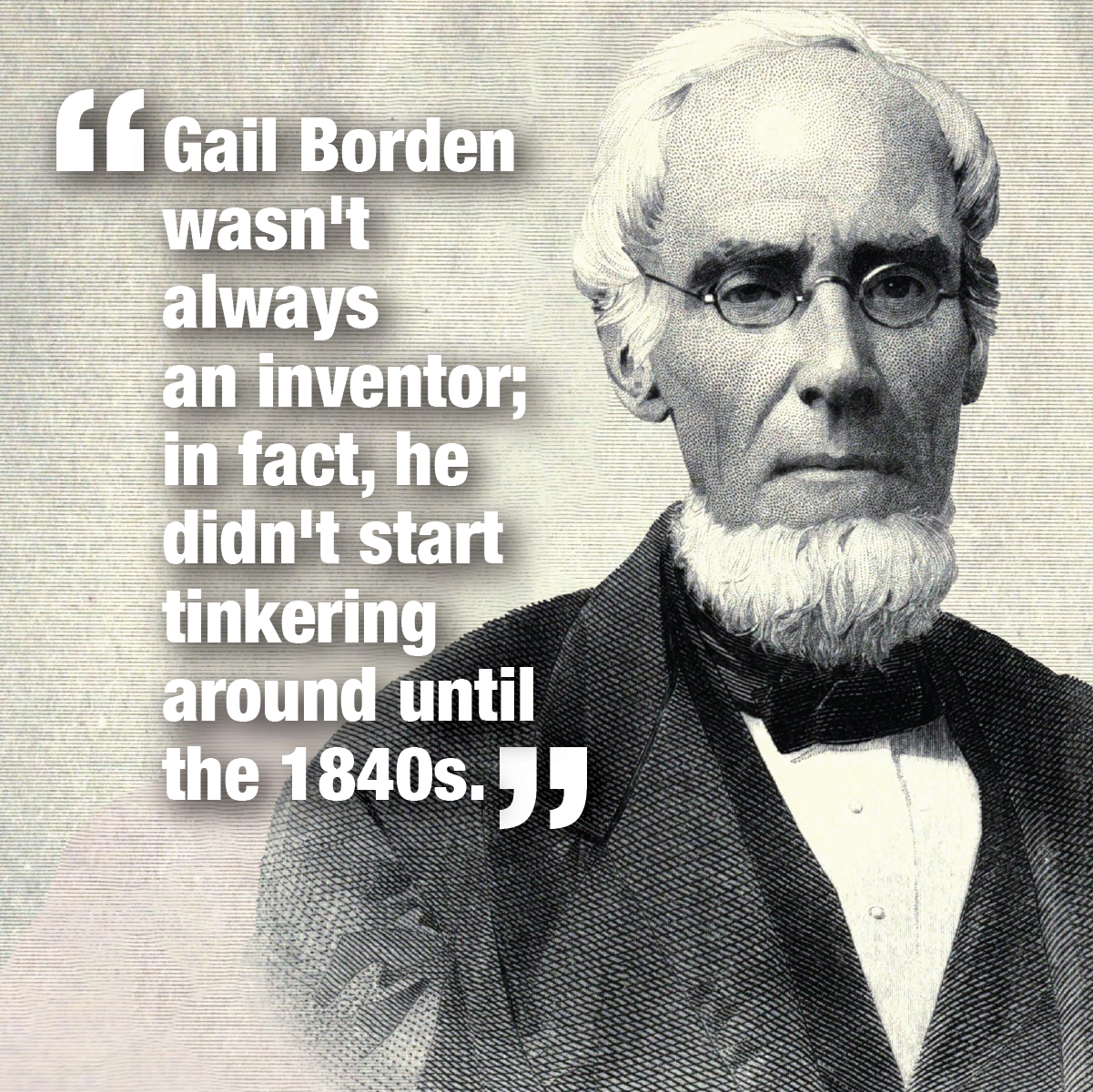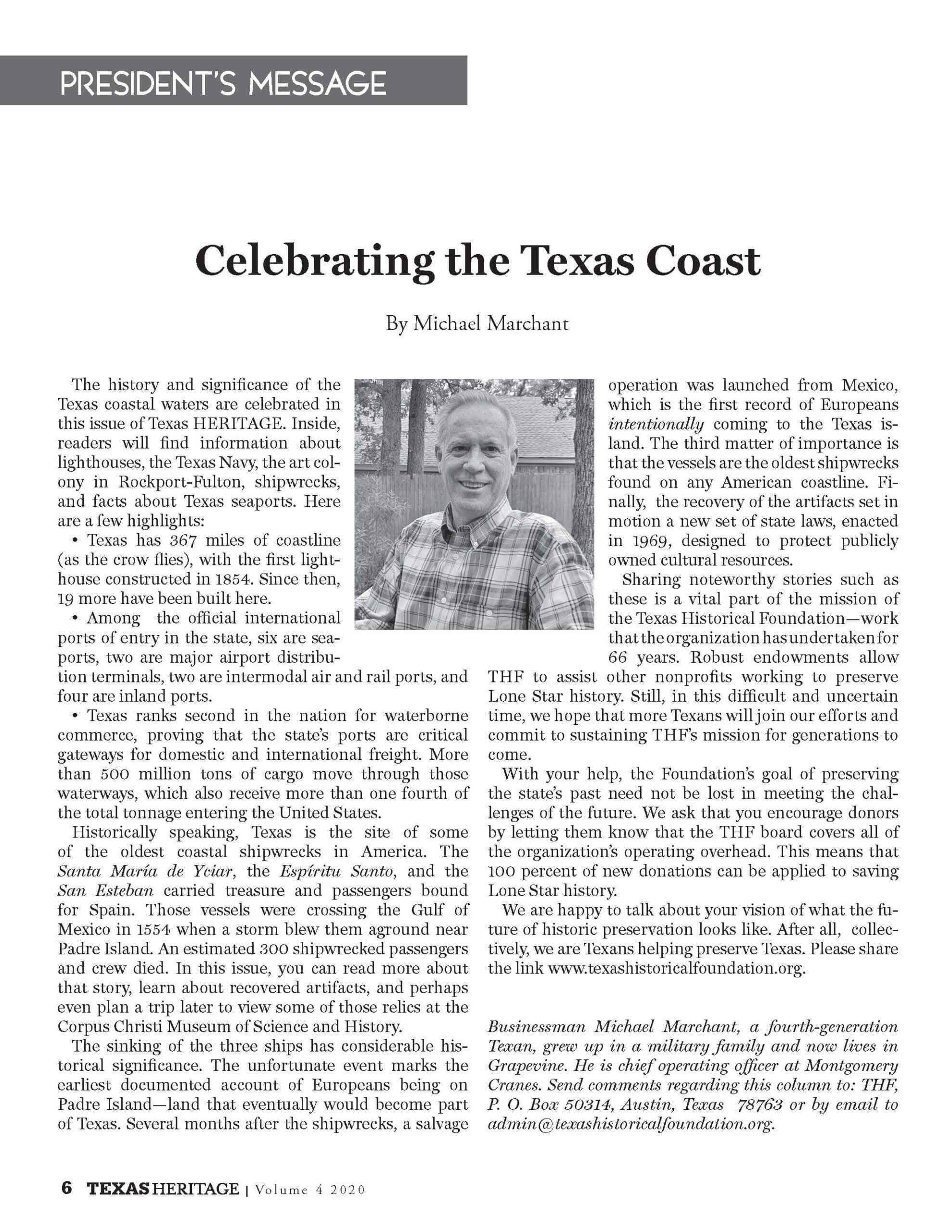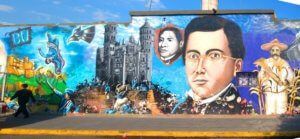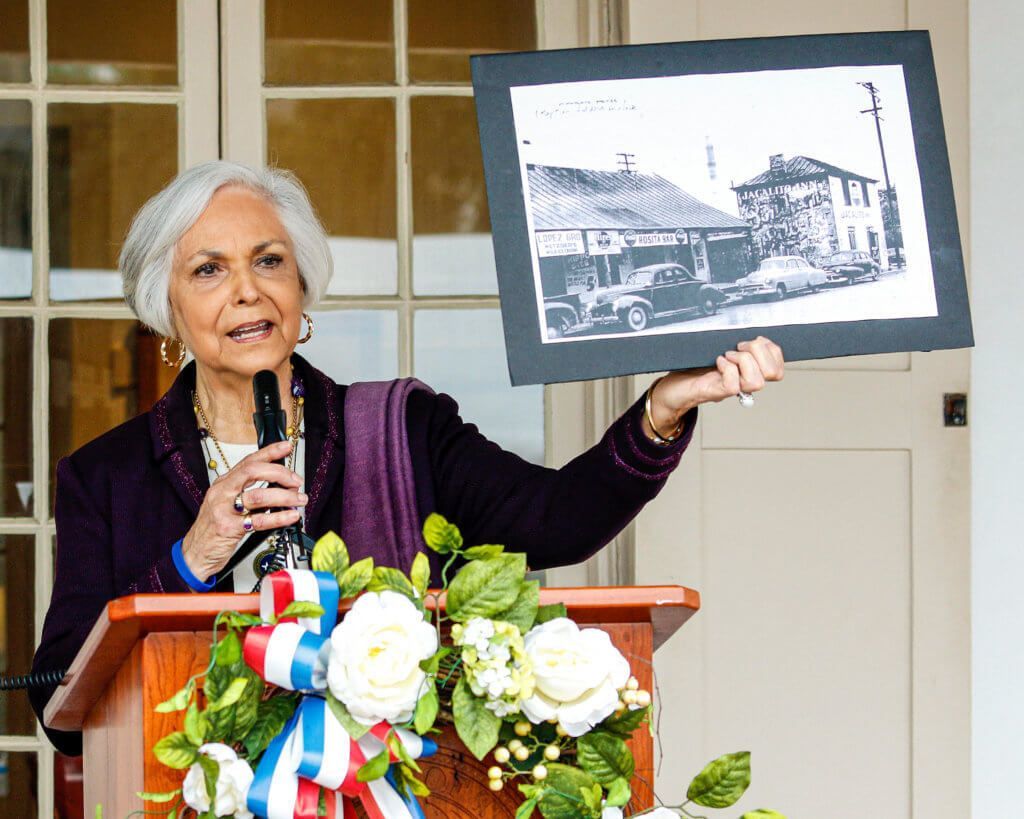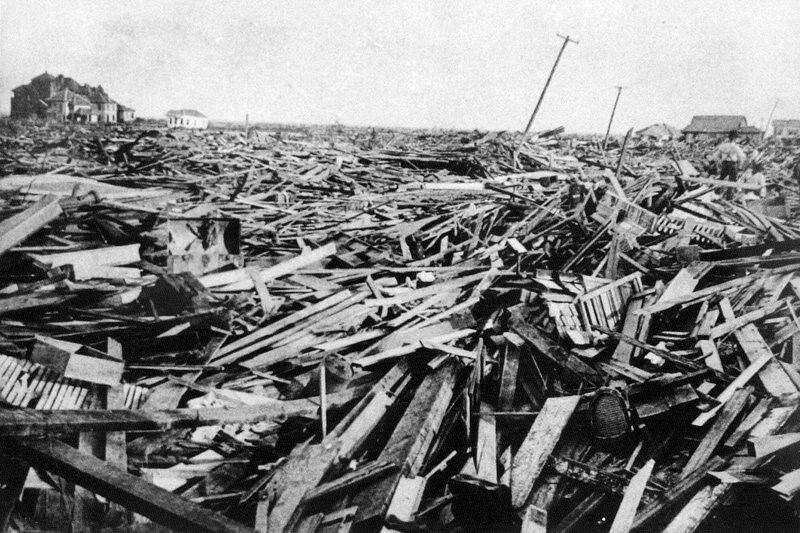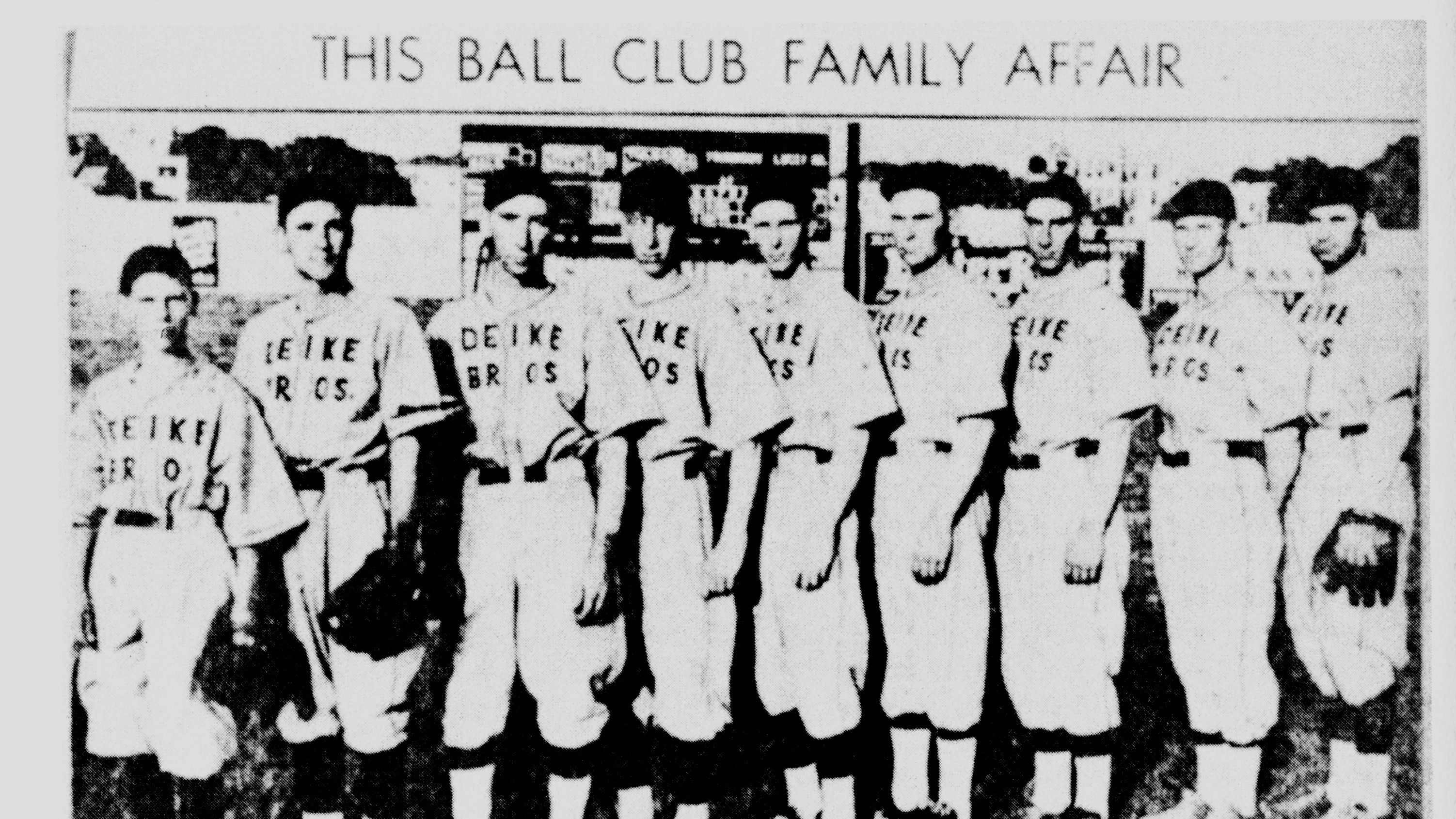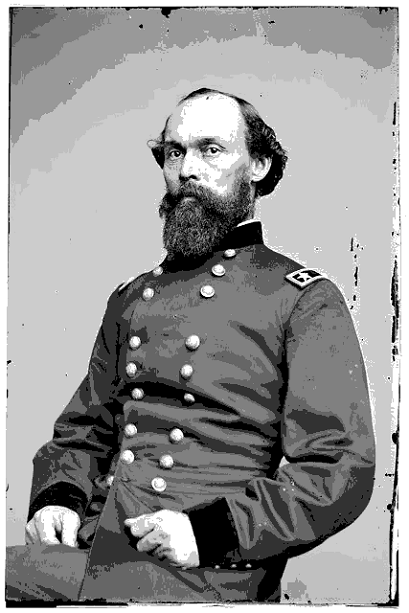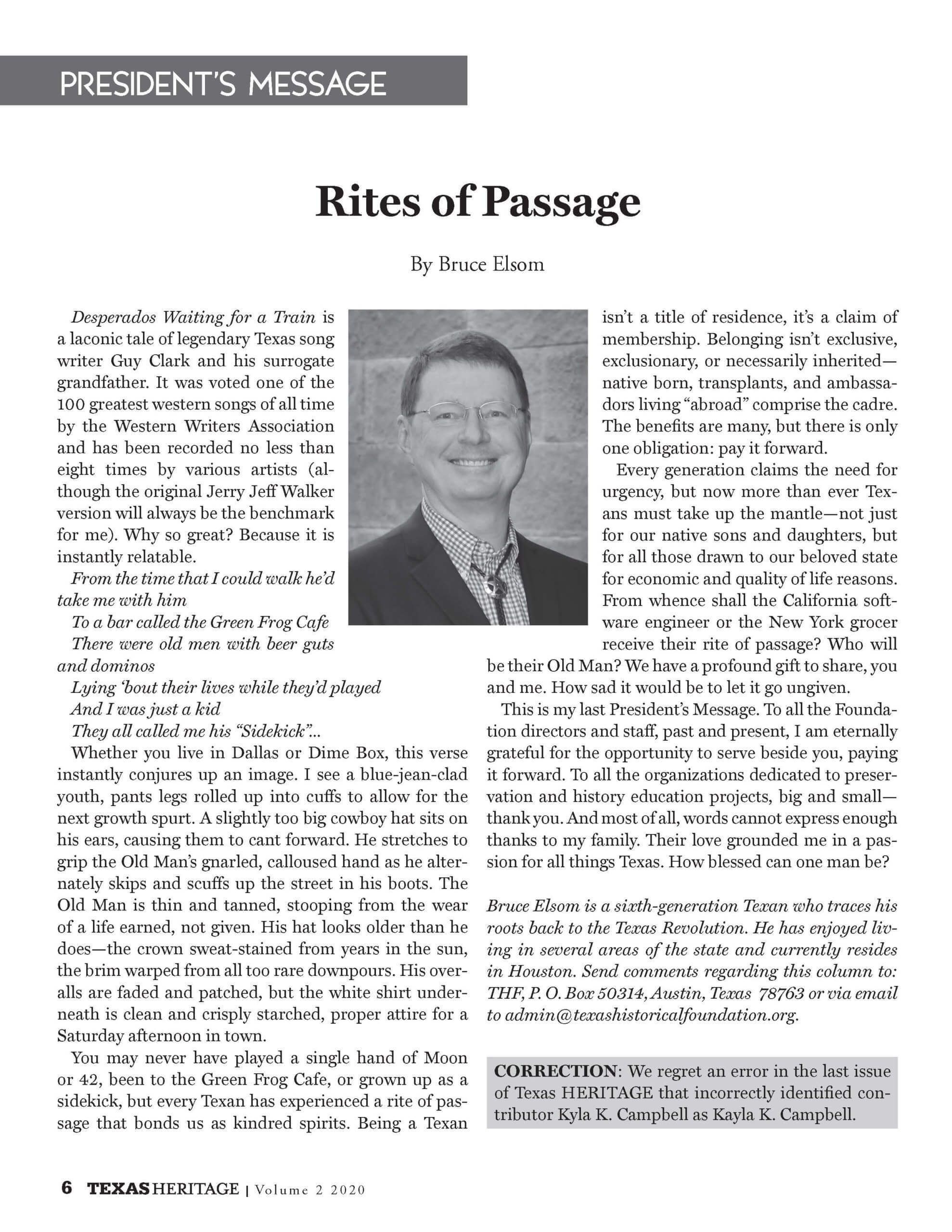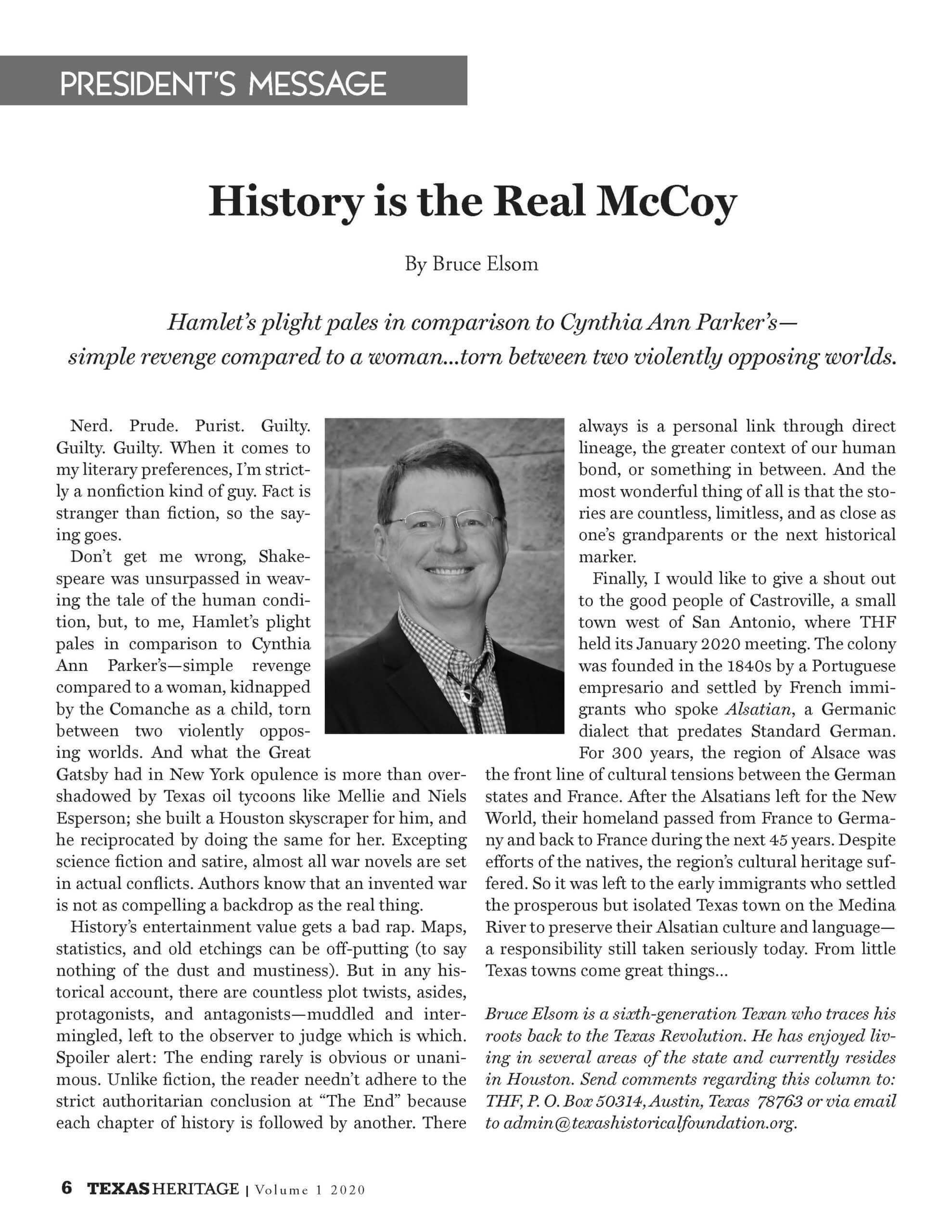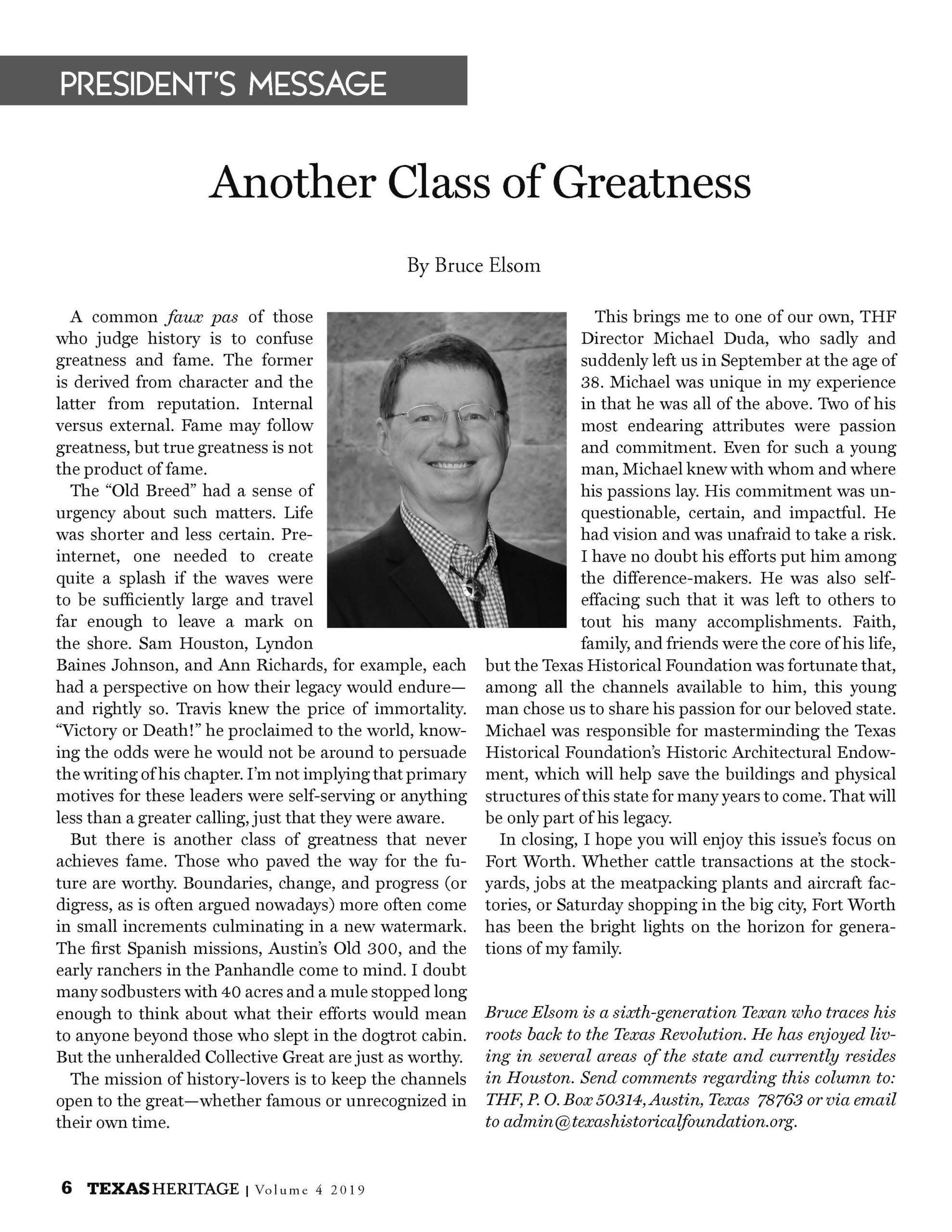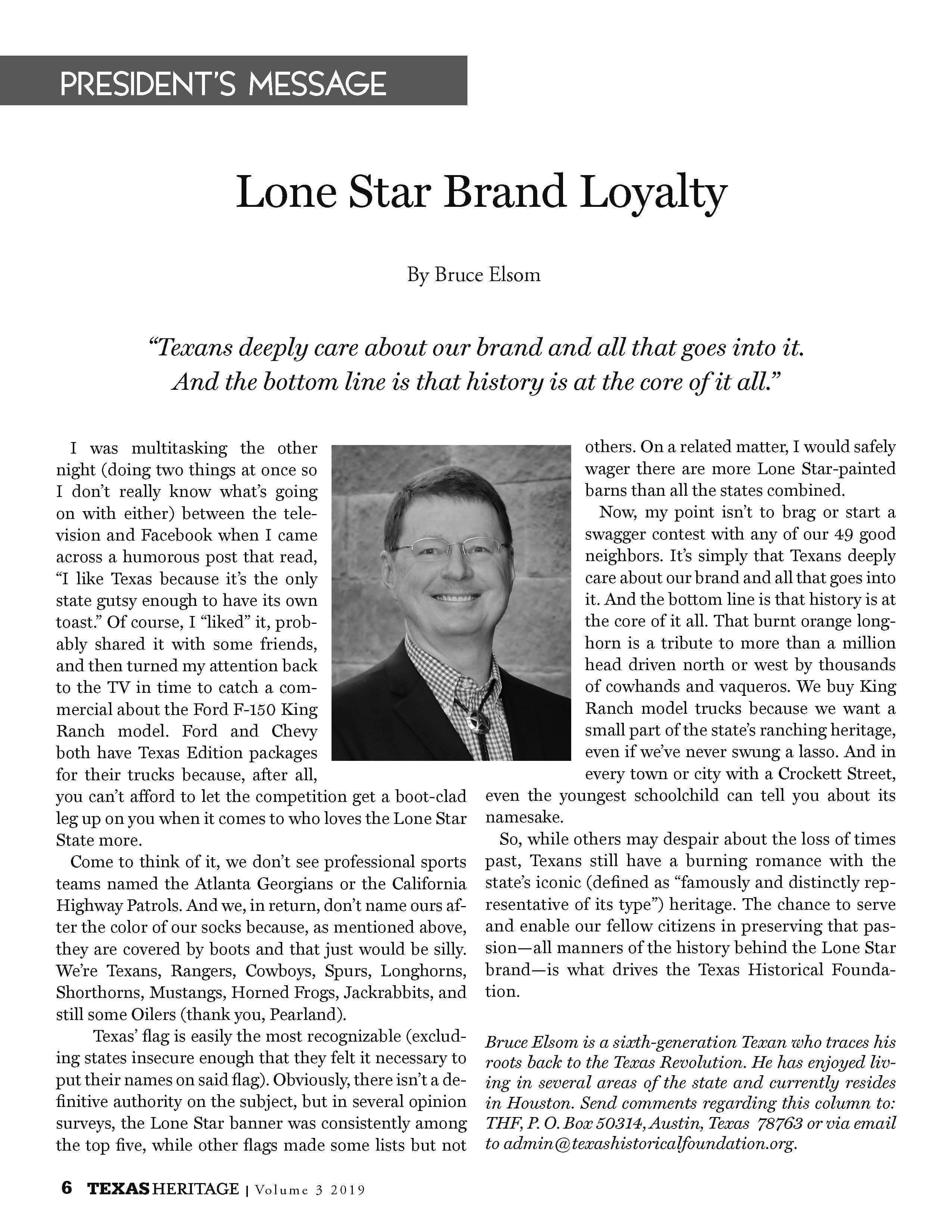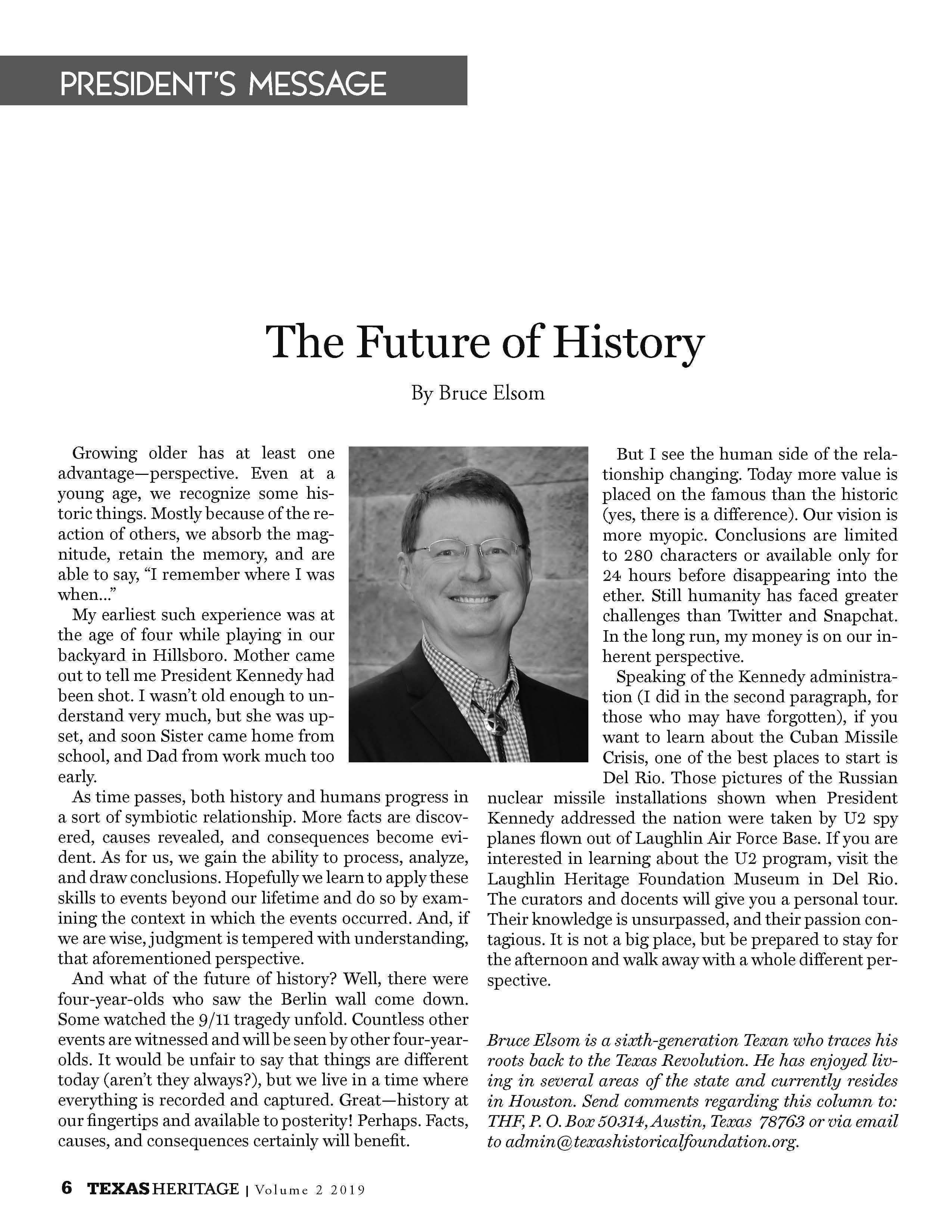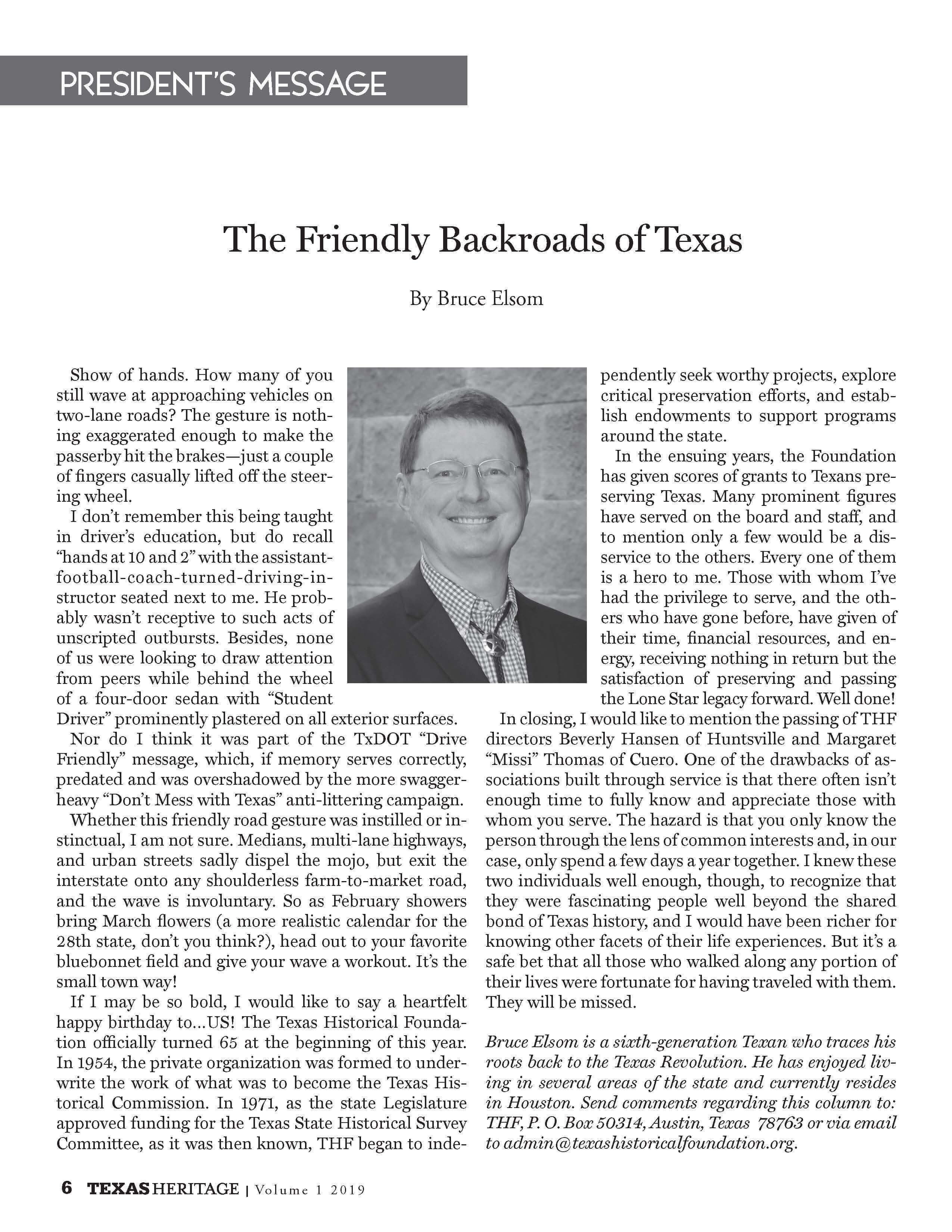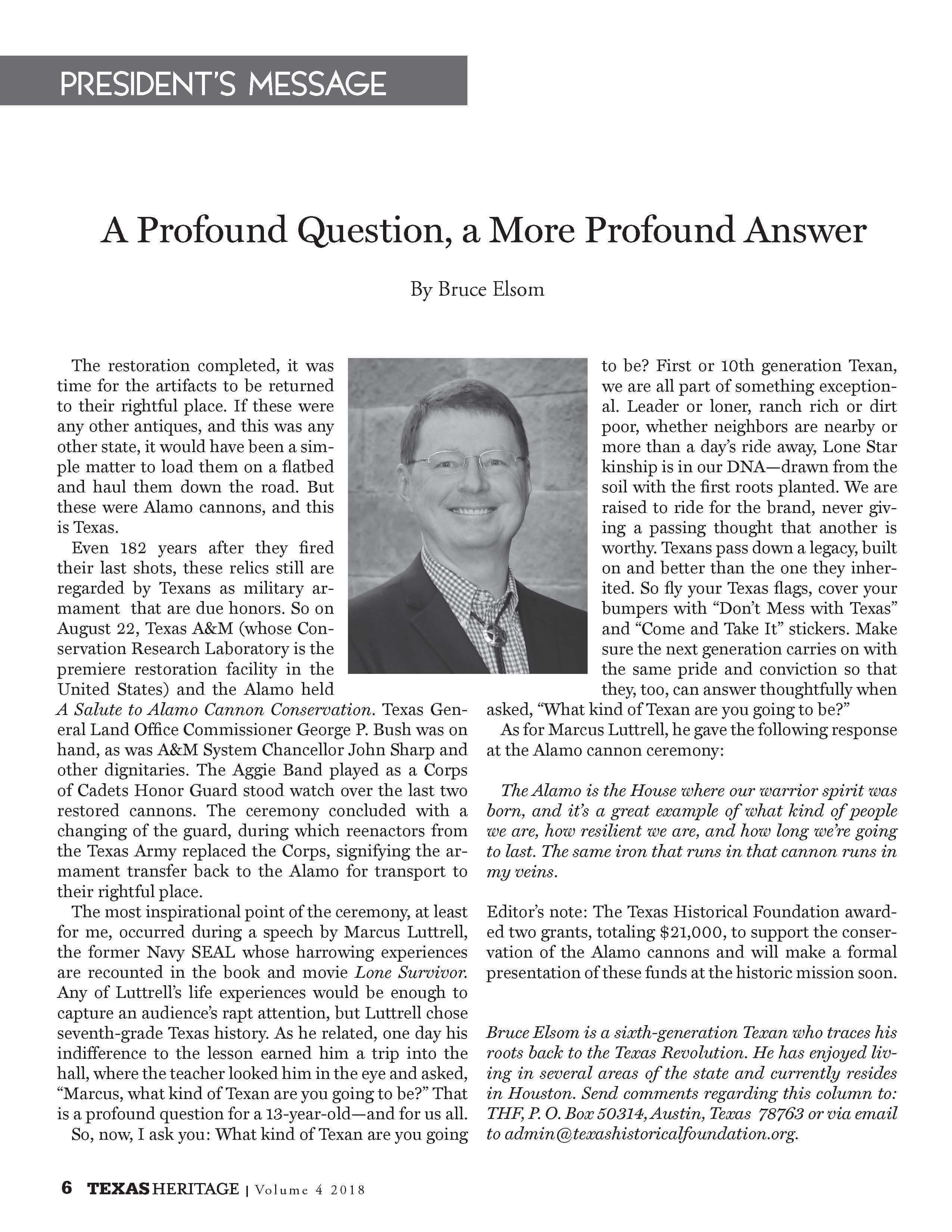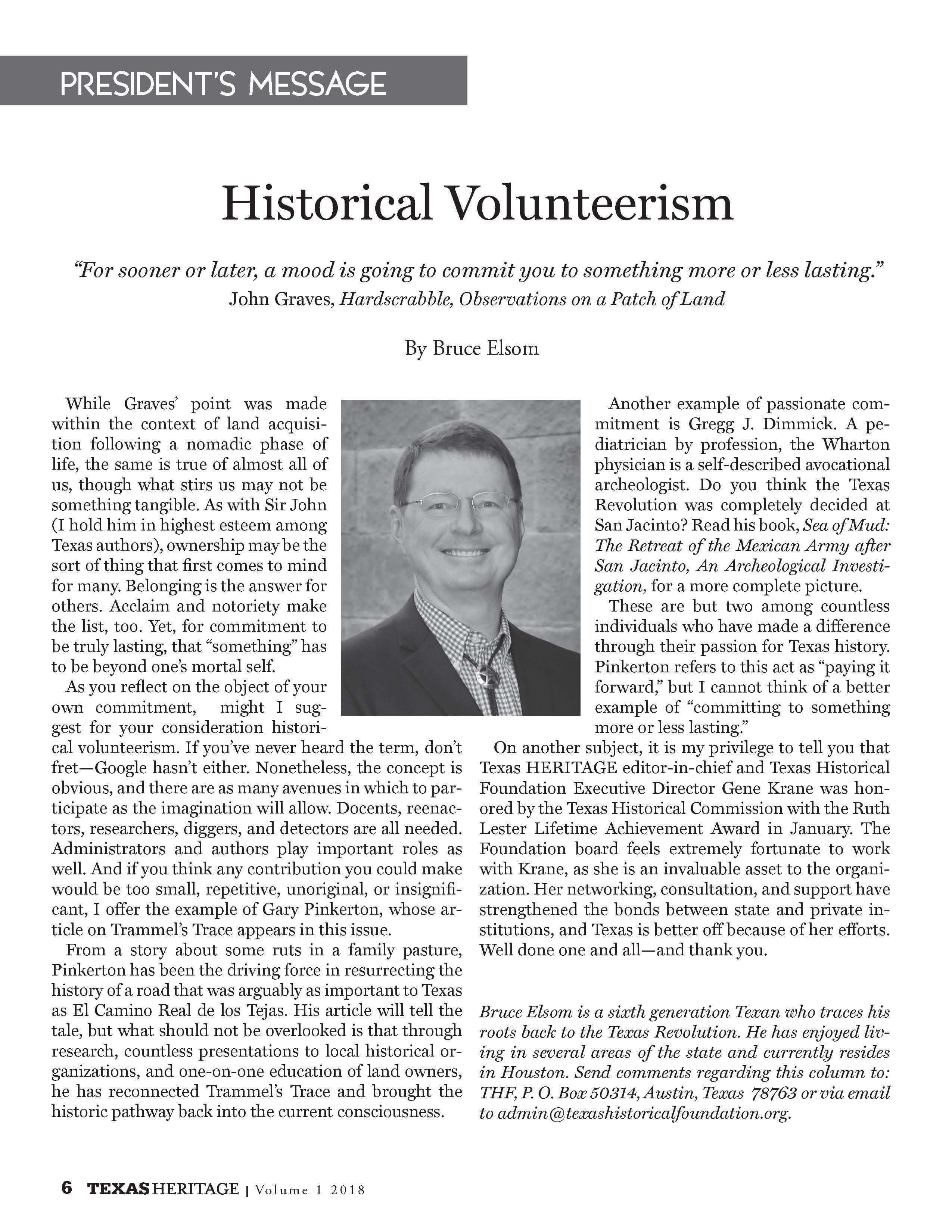This year for Halloween, we are revisiting one of our past favorites: The Jefferson Historical Society Museum's “Sitting Up with the Dead: A Victorian Mourning Exhibit." The exhibit, which we visited in 2024, explored 19th-century mourning customs, including a few eerie photographic effects and practices.
More than 10,000 years ago, prehistoric peoples in Texas crafted stone spear points to hunt mammoths, bison, and other animals. These finely made tools — known today as projectile points or, colloquially, as “arrowheads” — are among the oldest evidence of human life in North America. The Texas Fluted Point Survey is documenting and mapping these artifacts in Texas to expand our understanding of our state's earliest inhabitants.
In 2024, the inaugural year of the Duda Preservation Awards, the Friends of the Wheelock School House won the top prize for their efforts to restore the 1908 Wheelock School House.
Texas Takes Shape: A History in Maps from the General Land Office is a visually stunning, richly curated journey through five centuries of cartographic history that features over one hundred rare and beautifully reproduced maps from the Archives of the Texas GLO.
The Star of Texas Award honors individuals, or businesses, for their exceptional contributions toward preserving the Lone Star State’s history and culture while inspiring its future. This year, we are pleased to announce Dale Sellers and Phoenix I Restoration and Construction as our honoree.
2024 was a record-breaking year for Texas Historical Foundation giving, with more dollars delivered to Texas preservationists than at any other point in our organization's history. Read on to find out where THF grants and awards made a difference in 2024.
Caddo Indian pottery is a significant aspect of the cultural heritage of the Caddo Nation, a Native American tribe that originally lived in areas that are now parts of Texas, Louisiana, Arkansas, and Oklahoma. THF Board Member Lane Transou writes about their pottery, renowned for its intricate designs and functional artistry, and how it evolved significantly over the centuries to reflect social changes, tribal economic status, and tribal autonomy.
Brenham Heritage Museum has a new permanent exhibit! The interactive European Immigration Kiosk explores the cultural roots of the Texas hill country community, weaving stories of the European immigrants who settled in Washington County in the mid-1800s.
Eight nonprofits were approved for THF grant funding at our Summer 2024 board meeting. The grants support projects that are designed to preserve Texas history and culture, some at a statewide level and others on a more focused, local level.
New Museum Focusing on Texas’ Mexican American History Coming to Dallas
Ten Texas Non-Profits Chosen to Receive Texas Historical Foundation Grants for Spring 2024
Fire destroyed the historic Royse City Methodist Church on May 28, 2024. The church was designed by James E. Flanders, one of Dallas' earliest architects, and completed in 1904.
An excerpt from David Preziosi's upcoming article in Authentic Texas magazine details the life and legacy of William Sidney Pittman, Texas' first Black architect. Pittman gained national acclaim for his architectural designs at a time when few Black architects practiced. Many of his buildings were demolished, but the Knights of Pythias building in Dallas stands today as one of his most important works.
The Clay House is an important contributing structure in the Zion Hill Historic District in Nacogdoches and an excellent example of early-20th-century architecture. The African American Heritage Project is currently restoring the house into a community center and local history museum, and their progress is impressive.
The Tom Lea Institute's Executive Director Holly Packard Cobbs tells us about an exciting new immersive mobile tour that highlights iconic native Texan artist and author Tom Lea.
Texas Historical Foundation may have “historical” in its title, but our work involves protecting all of Texas’ heritage – both historical and prehistorical.
Not far from St. James Palace in London, you can find a plaque on the side of 300-year old liquor store that pays tribute to the former location of the Texas Legation, established when the Republic of Texas was newly formed and installing delegations in Washington DC, Paris, and London. This history would be forgotten by most if not for the efforts of the Anglo-Texas Society to commemorate it in 1986.
Two Preservation Texas Summits were held in September, one in Tyler and one in San Marcos. The summits highlighted historic preservation efforts in their region and included a wide variety of fascinating topics.
Update on the Dell Motley leather artwork restoration in progress at Nocona's Tales 'N' Trails Museum.
The northwestern Texas border once extended to the Rio Grande River in northern New Mexico and Colorado during the period that Texas was a sovereign state between 1836 and 1845. By 1850, the state took the familiar shape that we all know and love today.
In rural Royse City, a remarkable other-worldly structure called a Futuro House has been a beloved landmark for decades.
A photo-essay of our trip to four historic painted churches in the Texas hill country, plus a route guide for the history-curious traveler.
The exact location of the Battle of Medina site has been a mystery for years. American Veterans Archaeological Recovery (AVAR) found compelling new evidence that points to the actual location of the battlefield during their 2022 fieldwork season.
The Wise County Heritage Museum was destroyed in a devastating early-morning fire on Saturday, March 18, 2023. We provide a short history of the museum, and extend our deepest sympathies to the museum staff and Commission for this enormous loss of Texas history.
It’s easy to lose oneself for hours in the Texas Historical Commission’s Texas Time Travel website. The site is part of THC’s Texas Heritage Trails Program, an initiative that was created in 1998 to highlight historic places across Texas and to promote education about our state history through travel.
The 1856 Neill-Cochran House in Austin is remarkable for many reasons. Its architectural significance is obvious, but it is also significant for a history that has not been widely told and that Neill-Cochran House Museum Executive Director Rowena Dasch and her staff have been working since 2016 to uncover.
The future is looking bright for Bolivar Point Lighthouse in Galveston Bay, built in 1872. The structure is in dire need of repairs before the iconic cupola falls and the structure is lost forever. Thankfully, the lighthouse has passionate advocates who are tirelessly working to ensure this never happens and that it is preserved for many generations to come.
The Brenham Heritage Museum's grand opening in a decommissioned Classical Revival style post office built in 1915 is set for Thursday, November 17 at 1:00 pm. Earlier this month, Texas HERITAGE Editor Gene Krane toured the museum with BHM Executive Director Mike Vance.
As the earth warms and climate change affects the planet in ways humankind is still discovering, natural disasters have become increasingly frequent and unpredictable. Devastating hurricanes, destructive droughts, and raging wildfires threaten lives and landscapes, creating what some have called a new normal. While saving people and homes is always a priority in these situations, precious historical and cultural resources are often also in harm’s way.
Hugh Edmondson’s family are ranchers in Ballinger, outside of San Angelo. A simple discovery began a journey by Edmondson that would eventually lead him to assemble what is now a collection of spurs that includes examples covering a span of 120 years. There are collectors who simply want to own artifacts, and there are others who seek to know about the history of the items they have assembled. Edmondson falls into the latter category.
Even though her career as a news reporter and producer required Olive Talley to stay on top of major news in Texas and the Southwest, she had never heard of the Gault archeological site—located only 160 miles from her Dallas home—when she traveled to Antarctica on a 2017 National Geographic expedition. Talley discovered that as archeologists were uncovering artifacts from the Central Texas site, they were also exposing new theories about the settlement of the New World...
Austin’s Treaty Oak is a tree, but it’s also a story. It’s the kind of tale that’s recounted in children’s plays, like Austin’s version of the first Thanksgiving.
The latest issue of the Texas Historical Foundation’s award-winning Texas HERITAGE magazine featured stories from the state’s borderlands, including articles about Petra Vela Kenedy and another on the return of an ancestral burial place in Presidio to members of the Lipan ApacheTribe. For those interested in the Texas borderlands, here’s another resource to explore.
While La Villita is often described as San Antonio’s first neighborhood, it is more appropriately described as San Antonio’s first suburb.
For many years, San Antonio has been known for its casual blending of cultures. Writers in the 19th century often mentioned the mixture of languages and skin colors when describing the people of San Antonio, an unexpectedly quirky place on the western frontier. But the city did not always have a blended character.
Though known for his building designs, Henry Trost was also an inventor. One of his more interesting ideas—the outside/inside bed—was touted in Southern Architect and Building News April 1922 issue as a “unique and one of the most remarkable achievements.”
North American colonial ranchers first observed the effects of southern cattle fever, a tick-borne disease, as early as the mid-eighteenth century. Symptoms included “high fever, swollen spleen, engorged liver, thick bile, and bloody urine.” Although the disease originated outside of Texas, it became increasingly prevalent among Texas longhorns.
Director and producer Olive Talley introduces the newest component of the story of the Gault Archaeological Site in Central Texas: the Gault Film. Talley gives us a sneak peek into the the life of eminent Texas lithic archaeologist Mike Collins and his 30 year journey to preserve this remarkable site and its wealth of knowledge.
Jessica Lee Hamlin, executive director of the Shumla Archaeological Research & Education Center (SHUMLA), an organization investigating the prehistoric rock art murals of the Lower Pecos Canyonlands, discusses the merits and complications of digital preservation.
A father-and-son duo join forces to talk about history education at The Landmark Inn, a historic lodging-turned-museum in Castroville. David is the director at the historic site, and his 12-year-old son leads visitors through the site’s Alsatian-style buildings on his unique 'Kid Tours'.
By mid 1836, Mark Epperson had built a ferry at the crossing of Trammel’s Trace and Sulphur Fork in present-day Bowie County. The treadwheel boat transported animals, cargo, and mail, and a small settlement built up around the crossing—before roads and railroads ushered in a new era of transportation.
Juneteenth commemorates June 19, 1865, when federal troops arrived in Texas and declared slaves free. General Order No. 3 by Union Army General Gordon Granger showed that the U. S. Army was in the state and committed to emancipation—more than two years after Abraham Lincoln’s Emancipation Proclamation.
Born in a small Texas town, James Earl Rudder was an educator before he was called to active duty and participated in the D-Day Invasion of Worl War II.
The Newton Boys were the most successful bank and train robbers in United States history. This is a brief account of their criminal escapades.
Texas Historical Foundation Director, William Jack Sibley, tells us about bumping into the author of BIG WONDERFUL THING, Stephen Harrigan, at a San Antonio market and about his amazing four-pound book about Texas.
Legendary Texas Ranger, Frank Hamer, became the archetypal lawman responsible for the capture of Bonnie and Klyde.
Kay Hindes, Texas Historical Foundation Director, talks about her start in historic preservation and why history is worth saving.
We sit down for a conversation with Sylvia Tillotson, Texas Historical Foundation Vice President - Dallas, about her work in historic preservation, her position with THF and why historic preservation is vital to understanding our future.
Gene Krane, Texas Historical Foundation Executive Director, shares how she unexpectedly entered the historic preservation field and encourages others to find their own historic interests.
Blog writer and historic preservationist, Bernie Sargent from El Paso, shares the story of Marcelino Serna from Mexico before the Mexican Revolution to the front line in France during World War I, to having a US Customs and Border Protection Port of Entry named after him.
Have you ever wondered what it's like to fail in life? Well, Gail Borden, a Texas inventor, didn't have to wonder. His life was filled with failure. In fact, Borden’s list of misses is fairly long. The amphibious boat and the meat biscuit take top honors. But there's one thing that separated him from everyone else: his ability to not give up. He always pushed forward and never looked back.
History is layered. Through our research, we learn about history through letters, diaries, archival records and edicts. There are volumes and volumes of books filled with them. But what we never consider are the personal stories weaved between the lines.
The Texas coastline, all 367 miles, is tattered with shipwrecks, cargo entry-ways cargo and tourist attractions. It also is where some of the oldest U.S. and Texas history can be found.
Mexican holidays have been celebrated in Texas since at least the 1750s, when it became popular to commemorate the feast of the Virgen de Guadalupe (December 12) with religious processions, dances, and bull fights.
Are you familiar with or do you know the name of Texas patriot José Antonio Navarro? As far back as I can remember, I knew my family was related to this famous Texas hero.
Galveston, Texas, the third-richest city in the United States in 1900, was one of the fastest booming places in the country. It was a prosperous port city full of grandeur, opulence, grace, and charm and had the potential of becoming the greatest city in the South–in other words, the New York of the Gulf. But all Galveston’s hopes and dreams were shattered in one day.
Hye, Texas, is not much of a place in terms of being a bustling burg. It has a post office—and a zip code—but never has been an incorporated town, per se. Hiram “Hye” Brown and his folks settled in this little patch of Blanco County in 1872...
Juneteenth, also known as Emancipation Day, Freedom Day, Jubilee Day, and Cel-Liberation Day, is an American holiday celebrated on June 19th. It memorializes June 19, 1865, when Union general Gordon Granger read orders in Galveston, Texas, that the Civil War had come to an end, and all previously enslaved people in Texas were free.
What "rites of passage" or sharing have you passed on to the next generation of Texans or to welcome new Texans?
Uncovering the "plots" and "twists and turns" of Texas history can be a compelling read. Thank you to our new friends in Castroville who shared their unique historical story with THF diretors.
Thoughts behind "greatness" and "fame" between Texas historical leaders and everyday Texans. Upcoming Texas HERITAGE magazine features articles on historic Fort Worth. THF mourns the loss of Michael Duda, former director,
Consider how historical events of today are uncovered and revealed with the introduction of 24 hour news cycles, social media and "alternate news" coverage compared with how historical events were unfolded 20 and 200 years ago. Consider traveling to Del Rio and Laughlin Air Force base's museum where you can see U2 photos of Russian military installations.
Enjoy the friendly back roads of Texas. Texas Historical Foundation celebrates 65 years of preserving Texas history. THF mourns the loss of two directors, Missi Thomas, Cuero, and Beverly Hanson, Huntsville.
"What kind of Texan will you be?" is the question Marcus Luttrell (former Navy SEAL and subject of the book and movie "Lone Survivor") was asked by his 7th grade Texas history teacher. Marcus shared this story at the military ceremony as seven cannons from the Alamo, after being restored and preserved, were returned.
Ancestral research is on the rise and helping family uncover their own histories. When visiting Austin, be sure to stop at the General Land Office's Archives. There are over 35 million documents and 45,000 maps to help you uncover more Texas history.
Volunteering for historical organizations can sometimes turn into more. Gary Pinkerton, through knocking on doors and wandering through woods, uncovered the original ruts that was part of the El Camino Real de los Tejas. Dr. Gregg J. Dimmick's curiosity led him to write "Sea of Mud: The Retreat of the Mexican Army After San Jacinto, An Archeological Investigation".
THF salutes architectural preservationist and their efforts by announcing the creation of a new endowment to be used for historic architectural preservation. Additionally, Lewis Fisher, THF Scholar Director and architect for many historical site preservations, has been selected to work on the Alamos Master Plan.
If we ignore our heritage roots in pursuit of identity, we should expect no less of future generations. If future generations turn aside who we are, then our aspirations and accomplishments are doomed by our own hand to decay with us. This is why history matters. And honoring our unique history is why being a Texan matters. THF to honor Charline and Red McCombs with third Star of Texas Award.
Archeological investigation is highlighted in Texas HERITAGE magazine including Panther Cave ancient rock art at the Amistad Reservoir and the origins of 19th-century Tejano ranchos in San Antonio. Both of these projects received THF grants from the Joseph Ballard Endowment.

